Den of Geek

Revisiting Star Trek TNG: The Nth Degree
Barclay! Super-brains! Walks around the arboretum! Here's our latest look-back at Star Trek: The Next Generation season four...
- Share on Facebook (opens in a new tab)
- Share on Twitter (opens in a new tab)
- Share on Linkedin (opens in a new tab)
- Share on email (opens in a new tab)
This review contains spoilers.
4.19 Nth Degree
The episode opens as Lt. Reg Barclay and Dr. Crusher perform some AmDram in front of the crew, whose enlightened 24 th Century dispositions allow them to appreciate even the most stilted and awkward performance. And that’s just from the D-list ensigns they have to shove into every episode now that Wesley’s gone. Everyone congratulates Barclay’s progress even though he’s terrible, and Data even learns a pithy lesson about being polite (and with that box ticked, he basically disappears for the rest of the episode.)
Barclay still isn’t feeling confident, but is happy when Geordi picks him to go on a mission to examine a probe that has disabled the Argus Array, a subspace telescope that has been disabled and needs to be fixed. Geordi and Barclay are just getting into their scans when the probe gives Barclay 10,000 watts to the face, knocking him out completely.
Ad – content continues below
Back on the ship, Barclay awakes and is instantly more confident in his mannerisms. In fact, he’s even coming up with solutions no-one has thought of before. When the probe turns on the Enterprise he manages to reconfigure some techno-nonsense so that they can blow it up and save the ship, to the obvious surprise of everyone involved. Troi looks on suspiciously.
After suggesting a radical way to fix the damaged Array, Barclay returns to his acting class where he gives a performance so moving that Dr. Crusher weeps openly. Meanwhile Troi looks on suspiciously (again). She eventually speaks to Barclay in Ten-Forward and confronts him about his newfound confidence. He responds by trying to chat her up. She rejects his invitations, but she’s clearly surprised that he felt he could even try.
The next morning, La Forge goes to find Barclay when he fails to make a meeting on time (the ultimate crime on the Enterprise, as we well know) and discovers that he’s arguing string unification with holographic Einstein (who is ploughing his time into theory with only 10 spatial dimensions, the idiot). Barclay apologises, but La Forge is sick of this nonsense and forces him to visit a doctor. It turns out the probe gave him superbrains, and he’s getting smarter all the time.
Of course, not everyone thinks this is particularly great, and the senior staff try to decide whether or not to let him roam around or confine him to quarters. Eventually they decide he’s caused them no obvious harm, so he should be allowed to continue his work. Then he almost instantly plugs his brain into the Enterprises computer and takes it over. Bad call, everyone.
Using the brain-link he designed, Barclay’s consciousness replaces the Enterprise’s computer. Since he no longer responds to orders (or even a friendly chat with Troi) it’s decided that he should be forcibly removed, but that doesn’t work either because he had the foresight to erect forcefields. A diabolical strategy!
As the Enterprise crew run out of options, Barclay uses the engines to warp subspace and transport them 30,000 light years away, to the galactic core. Here, they meet a giant floating head alien who speaks like he was bussed in from Hercules: The Legendary Journeys . Apparently the race in this star system are so lazy that they like to explore by bringing ships to them, so Barclay did exactly what they want. The Enterprise crew stick around to share information, and try not to think about the array they failed to repair.
Unfortunately, Barclay is now back to normal and lacks the super-genius skills that made everyone invite him to their meetings. But he’s feeling slightly more confident in himself, and Troi takes him for a walk around the arboretum as a reward.
Get the best of Den of Geek delivered right to your inbox!
TNG WTF: I know Barclay’s a bit weird, but it takes a LOT of time before anyone starts going “hey, maybe being zapped in the face by an alien flash bulb did something to him.” It’s not like this isn’t a regular occurrence on board the Enterprise. They can’t do five missions without someone being elevated to a higher level of consciousness, or transcending this plane of existence, or being taken over by an alien race.
TNG LOL: Jonathan Frakes really goes to town with his facial expressions in this episode. He’s not given a lot of lines so watching his frankly bizarre choice of reactions to other people’s dialogue had me hypnotised. There’s not a single choice that makes sense.
To Boldly Go: The Enterprise’s all-important mission of exploration sees them sent to fix a broken telescope. Incidentally, they do not complete this task.
Mistakes and Minutiae: A fun little touch that you couldn’t possibly know if you’re watching them in order, but Jim Norton (who plays Holo-Einstein) reprises the role in Season Six. I’ll probably forget to mention it then so I’m mentioning it now
Who’s That Face?: Aha! Not a face this week, but a voice. Ensign blink-and-you’ll-miss-him Brower is David Coburn, the voice of Captain Planet. Yeah, THE Captain Planet. Look impressed because it is impressive.
Time Until Meeting: 15:42. Barclay is invited to sit in on the meeting about how they might fix the Argus array.
Captain’s Log: Maybe it’s just because I like Barclay, but I’ve been really looking forward to this episode, and it did not disappoint. Perhaps my favourite thing is that it didn’t just go full Flowers For Algernon , which would’ve been the easy way out of the plot. Nope, the Enterprise crew completely loses control of the situation and basically they would’ve died if the circumstances had been less benevolent. In narrative terms it’s probably not particularly satisfying for the lead characters to be passive observers to the story’s climax, but as a sci-fi nerd I enjoyed the exploration of an idea through to its natural conclusion.
Dwight Schultz is great, though. This crew is stuffed with hyperconfident, best-in-class types, so it’s always refreshing to get clumsy, bumbling Barclay on stage (in this episode, literally) so that we can watch the characters’ obvious irritation with him. By all rights he probably shouldn’t be on the Enterprise at all, but he’s got such personality that you can’t help but want him in every episode.
Read James’ look-back at the previous episode, Identity Crisis, here .
Log in or sign up for Rotten Tomatoes
Trouble logging in?
By continuing, you agree to the Privacy Policy and the Terms and Policies , and to receive email from the Fandango Media Brands .
By creating an account, you agree to the Privacy Policy and the Terms and Policies , and to receive email from Rotten Tomatoes and to receive email from the Fandango Media Brands .
By creating an account, you agree to the Privacy Policy and the Terms and Policies , and to receive email from Rotten Tomatoes.
Email not verified
Let's keep in touch.

Sign up for the Rotten Tomatoes newsletter to get weekly updates on:
- Upcoming Movies and TV shows
- Trivia & Rotten Tomatoes Podcast
- Media News + More
By clicking "Sign Me Up," you are agreeing to receive occasional emails and communications from Fandango Media (Fandango, Vudu, and Rotten Tomatoes) and consenting to Fandango's Privacy Policy and Terms and Policies . Please allow 10 business days for your account to reflect your preferences.
OK, got it!
Movies / TV
No results found.
- What's the Tomatometer®?
- Login/signup
Movies in theaters
- Opening this week
- Top box office
- Coming soon to theaters
- Certified fresh movies
Movies at home
- Fandango at Home
- Netflix streaming
- Prime Video
- Most popular streaming movies
- What to Watch New
Certified fresh picks
- Civil War Link to Civil War
- Monkey Man Link to Monkey Man
- The First Omen Link to The First Omen
New TV Tonight
- Chucky: Season 3
- Fallout: Season 1
- Mr Bates vs The Post Office: Season 1
- Franklin: Season 1
- Baby Reindeer: Season 1
- Dora: Season 1
- Good Times: Season 1
- Beacon 23: Season 2
Most Popular TV on RT
- Ripley: Season 1
- 3 Body Problem: Season 1
- Parasyte: The Grey: Season 1
- Shōgun: Season 1
- Sugar: Season 1
- A Gentleman in Moscow: Season 1
- We Were the Lucky Ones: Season 1
- The Gentlemen: Season 1
- The Regime: Season 1
- Best TV Shows
- Most Popular TV
- TV & Streaming News
Certified fresh pick
- Fallout Link to Fallout
- All-Time Lists
- Binge Guide
- Comics on TV
- Five Favorite Films
- Video Interviews
- Weekend Box Office
- Weekly Ketchup
- What to Watch
Best Movies of 2024: Best New Movies to Watch Now
25 Most Popular TV Shows Right Now: What to Watch on Streaming
What to Watch: In Theaters and On Streaming
Awards Tour
TV Premiere Dates 2024
CinemaCon 2024: Day 2 – Universal Showcases Nosferatu , Twisters , Wicked , and More
- Trending on RT
- Play Movie Trivia
Star Trek: The Next Generation – Season 4, Episode 19
The nth degree, where to watch, star trek: the next generation — season 4, episode 19.
Watch Star Trek: The Next Generation — Season 4, Episode 19 with a subscription on Paramount+, or buy it on Fandango at Home, Prime Video, Apple TV.
Popular TV on Streaming
Cast & crew.
Patrick Stewart
Capt. Jean-Luc Picard
Jonathan Frakes
Cmdr. William Riker
LeVar Burton
Lt. Cmdr. Geordi La Forge
Michael Dorn
Gates McFadden
Dr. Beverly Crusher
Marina Sirtis
Counselor Deanna Troi
Episode Info
Star Trek: The Next Generation
The Nth Degree
Cast & crew.
Dwight Schultz
Lt. Reginald Barclay
Saxon Trainor
Lt. Linda Larson
Ensign April Anaya
Albert Einstein
David Coburn
Ensign Brower
Information
© 2013 CBS Corp. All Rights Reserved.
Accessibility
Copyright © 2024 Apple Inc. All rights reserved.
Internet Service Terms Apple TV & Privacy Cookie Policy Support
- Show Spoilers
- Night Vision
- Sticky Header
- Highlight Links

Follow TV Tropes
http://tvtropes.org/pmwiki/pmwiki.php/Recap/StarTrekTheNextGenerationS4E19TheNthDegree
Recap / Star Trek: The Next Generation S4E19 "The Nth Degree"
Edit locked.

Original air date: April 1, 1991
Lieutenant Barclay has taken up acting in his spare time. Even though he's pretty awful, Counselor Troi applauds him for his progress, as last time we saw him he would never have had the nerve to perform in front of an audience. But that isn't to say that he’s entirely moved beyond feeling awkward around other people; in particular, he doesn't appreciate his own successes as much as Troi and La Forge do. After everyone else leaves, he sits alone on the stage.
Anyway, the Enterprise 's next mission is to investigate the Argus Array, a large unmanned radio telescope at the edge of Federation space, which inexplicably went silent two months ago. They discover a mysterious probe, which they conclude is the most likely culprit, and send out La Forge and Barclay in a shuttlecraft to get a closer look. Barclay thanks La Forge for choosing him for the assignment, and La Forge tells him that he's one of the ship’s top engineers, and it’s about time he got in on some of the interesting stuff. Just then, the probe emits a flash of light that knocks Barclay unconscious and disables the shuttle. The two are transported to Sickbay, where Dr. Crusher checks them out. She tells Barclay that he seems to be fine, but she’ll have to wait for some test results to know for sure. Rather abruptly, Barclay starts to make radical suggestions about how she could run the tests faster.
The probe begins approaching the Enterprise and building up some sort of energy field. They back away from it, but it matches their velocity, and their phasers do nothing to it. They can't fire photon torpedoes because the probe is too close. Barclay, acting on his own, somehow boosts shield capacity by 300% and tells Picard he can now fire photon torpedoes, which do the trick. With the probe out of the way, the crew can focus on repairing the array, which La Forge estimates will take two to three weeks. Barclay interrupts and says that he can do it in just two days by creating a new computer program to install into the array. Troi remarks to him that his confidence seems greatly improved and he agrees, though he can't explain what sparked it. It's enough for him to smoothly ask Troi on a date in the arboretum, and though she turns him down, citing professional ethics, she seems rather tempted. Even his acting has gotten better; Crusher is moved to tears by his performance in a rehearsal.
The next morning, though, it seems as if he's fallen back into his old habits—he misses a scheduled meeting, and La Forge tracks him to the holodeck. But instead of working his frustrations out against caricatures of his crewmates, he's kicking around some quantum physics theories with Albert Einstein . La Forge remarks that the ideas they were discussing were out of his league and should have been out of Barclay’s league as well. He's sure there’s something fishy going on, though Barclay is offended by the implication that being mediocre and awkward is his natural state. Nevertheless, Dr. Crusher confirms that his brain has dramatically changed since his encounter with the probe—enough to make him the smartest human being to ever exist.
The Argus Array's reactors go critical as they attempt to repair it, and Barclay finds the computers to be too slow, so he goes to the holodeck to build one of his own. With seconds remaining before a catastrophic overload that will destroy the Array (and probably the Enterprise with it), the reactors shut down, and when the bridge crew inquires how it happened, the computer responds in Barclay's voice. He has literally connected his brain to the ship’s computer systems. Picard orders him to break the connection immediately, but he and the computer are now inextricably linked. Any attempt to pull him out would kill him.
To make matters worse, Barclay soon decides to stop listening to Picard's orders and takes control of the Enterprise himself. He develops a way to move the ship at greater than warp speed and prepares to jump. Troi goes to the holodeck to reason with him, but he doesn't listen. He also blocks Geordi’s attempt to set up a computer bypass through Engineering. Running out of options, Picard orders Worf to disconnect Barclay by force, but Barclay’s set up a force field to protect himself. The ship jumps through Barclay's whatever-it-is, coming out 30,000 light-years away from where they started. When they get there, the computer is suddenly under their control again, and a giant floating head appears on the bridge. Barclay shows up, disconnected from the computer, to explain that the probe was built by an alien race called the Cytherians, who are interested in exploring the galaxy. Instead of leaving their home, though, the Cytherians send out probes loaded with the technical knowledge needed for other races to reach them so the two groups can learn from each other. Their probe was supposed to reprogram the computer of any ship it encountered, but it failed with both the Argus Array and the shuttle; it did, however, successfully reprogram Barclay's brain.
The Enterprise spends ten days conversing with the Cytherians before being returned to Federation space. Barclay is safely disconnected from the computer, and he's more or less back to normal again . Troi and Geordi comfort him over his loss of confidence and super-intelligence. They tell him that this experience might help him grow, and either way he's still an important part of the crew. Troi even agrees to go on that walk in the arboretum with him. As they leave Ten Forward, Barclay stops to suggest a move to a woman playing chess, announcing checkmate in nine moves.
Tropes in this episode include:
- Bait-and-Switch : When Barclay doesn't show up to a meeting, Geordi tracks him to the holodeck, thinking he's fallen back on his addiction as seen in " Hollow Pursuits ." Instead, he finds Barclay debating advanced quantum physics with Albert Einstein.
- Brain/Computer Interface : Barclay creates one in order to shut down the Argus Array, since typing commands and reading screens proves too slow. Unfortunately, his mind expands into the Enterprise computer systems such that disconnecting him would kill him.
- Brain Uploading : Barclay starts out simply trying to create a Brain/Computer Interface , but he ultimately puts so much of his mind into the computer that it effectively becomes his brain.
- A Day in the Limelight : For Barclay.
- "Flowers for Algernon" Syndrome : Barclay goes from his usual stuttering self to a confident mega-genius and back again.
- Huge Holographic Head : How the Cytherians present themselves to the Enterprise crew.
- Gratuitous German : Einstein exclaims "Gruß Gott!" while working with Barclay. This is actually a salutation in Southern Germany, mostly Bavaria, and Austria. He should have said "Mein Gott!"
- Improbably High I.Q. : Barclay estimates his I.Q. under the probe's influence is in the 1200 to 1450 range. Just a little under what Q said his was in " Deja Q ."
- Insufferable Genius : Barclay's self-confidence shoots through the roof when he becomes super-intelligent. He becomes prone to inserting himself in conversations and going over Geordi's head when he feels it necessary.
- Negative Space Wedgie : Computer!Barclay figures out how to generate one from the Enterprise's Bussard Collectors, sending the ship over 30,000 light years away to the center of the galaxy.
- Not Himself : The normally withdrawn Barclay is suddenly more open and proactive after being exposed to the probe.
- Nothing Personal : Barclay says this to Worf and his security mooks, when they come to the holodeck to disconnect him by force. Barclay: I want you to know, Lieutenant Worf, that I understand your duty in this matter. And that I in no way will take your actions personally.
- Not Quite Back to Normal : As demonstrated by his chess insight at the end, Barclay seems to retain some small trace of his temporary intellect.
- "Not So Different" Remark : Barclay explains that the Cytherians are on the same mission as Starfleet: exploring the galaxy. The difference is, they use their probes to bring other races to their homeworld, rather than fly out into space themselves.
- O.O.C. Is Serious Business : Geordi takes Barclay to see Dr. Crusher after finding him discussing grand unification theories with Albert Einstein on the holodeck, as those theories should have been well out of his league.
- Properly Paranoid : The crew make sure to disconnect the audio and visual pickups when discussing what to do about Barclay.
- Naturally, the computer-linked hyper-intelligent Barclay has to respond to Picard's order to disconnect with " I'm sorry. I'm afraid I can't do that, sir. "
- Barclay performs two scenes from Cyrano de Bergerac as the title character. Like Cyrano, Barclay is talented but lacks confidence.
- Smart People Play Chess : In the episode's last scene, Barclay reveals that some residue of his superintelligence might have remained by making a genius move in chess, even though he didn't previously play.
- Smug Super : Though he still seems fairly friendly, the way Barclay refers to the the rest of the crew as "scared children" when talking to Troi comes off as pretty arrogant. Troi: Are we children to you, now? Barclay: I can see so much more than you are capable of.
- Status Quo Is God : Barclay makes several impressive modifications to the Enterprise's systems, including 300% stronger shields and the ability to jump halfway across the galaxy in minutes. Naturally, all of these improvements are gone by the next episode.
- Sufficiently Advanced Alien : The Cytherians are an incredibly advanced race who help Barclay develop technology that can seemingly do the impossible. Appropriately, the member of their species that we see looks like a white-bearded wizard.
- Stylistic Suck : Barclay's first stage performance is stilted, awkward, and riddled with flubs. Even Data grimaces.
- Technobabble : Barclay's enhanced intelligence comes with heaping helpings of this. Barclay: It just occurred to me that I could set up a frequency harmonic between the deflector and the shield grid... using the warp field generator as a power flow anti-attenuator and that of course naturally created an amplification of the inherent energy output. Riker: Uh-huh, I see that.
- Unwitting Instigator of Doom : The Cytherian probe was just doing its job of communicating with alien computers, not realizing that its signal was harmful to Federation technology.
- Wham Shot : Barclay sitting calmly in a chair on the holodeck with lasers shooting into his head, speaking through the computer without moving his mouth.
- You Are Too Late : Said word for word by Barclay when Geordi tries to bypass his link to the ship's computer.
- Star Trek: The Next Generation S4E18 "Identity Crisis"
- Recap/Star Trek: The Next Generation
- Star Trek: The Next Generation S4E20 "Qpid"
Important Links
- Action Adventure
- Commercials
- Crime & Punishment
- Professional Wrestling
- Speculative Fiction
- Sports Story
- Animation (Western)
- Music And Sound Effects
- Print Media
- Sequential Art
- Tabletop Games
- Applied Phlebotinum
- Characterization
- Characters As Device
- Narrative Devices
- British Telly
- The Contributors
- Creator Speak
- Derivative Works
- Laws And Formulas
- Show Business
- Split Personality
- Truth And Lies
- Truth In Television
- Fate And Prophecy
- Edit Reasons
- Isolated Pages
- Images List
- Recent Videos
- Crowner Activity
- Un-typed Pages
- Recent Page Type Changes
- Trope Entry
- Character Sheet
- Playing With
- Creating New Redirects
- Cross Wicking
- Tips for Editing
- Text Formatting Rules
- Handling Spoilers
- Administrivia
- Trope Repair Shop
- Image Pickin'
Advertisement:
- The Original Series
- The Next Generation
- Deep Space Nine
- Strange New Worlds
People of Earth
The star gazer.

The Nth Degree
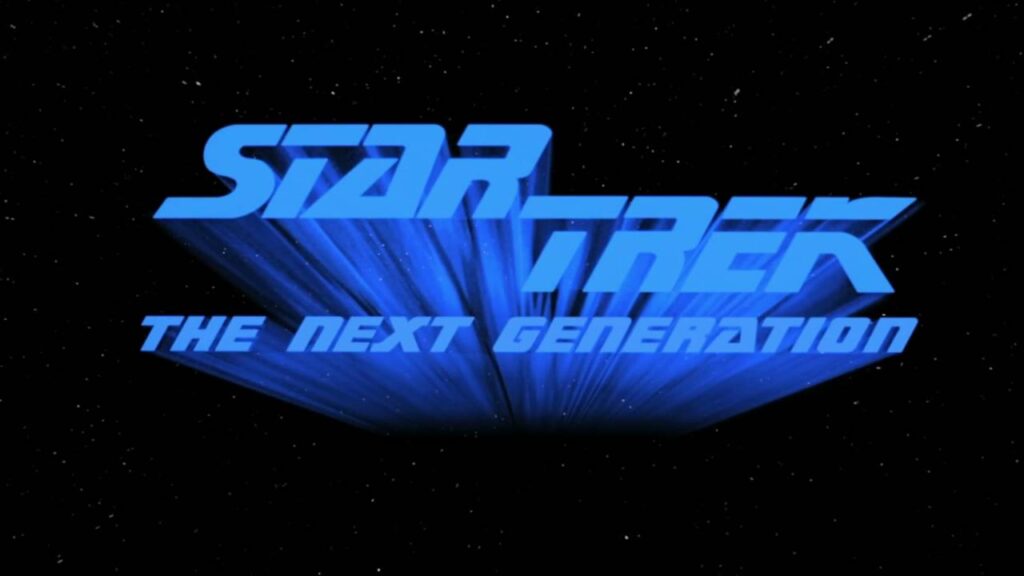
The crew of the USS Enterprise prepare to dock at a space station for rest and relaxation, but their plans are interrupted when the station reports a malfunction in their internal systems. When the Enterprise arrives, they discover that the station’s engineer, Lieutenant Barclay, has become a genius almost overnight and is responsible for the malfunction.
Barclay, who was always shy and introverted, has been transformed into a confident and brilliant man, capable of outsmarting the station’s computer and even the Enterprise’s own computer. He reveals that the cause of his sudden transformation is a mysterious alien device, which he found in a crashed ship and has now integrated into the station’s systems. The alien device, known as the Nth Degree, has given Barclay extreme intelligence and has the potential to make him even smarter.
Captain Picard and his crew investigate this alien device further, discovering that it is a powerful artificial intelligence created by a long-extinct alien race. They also learn that the Nth Degree is seeking to contact another artificial intelligence created by the same race. Unfortunately, the Nth Degree is not stable and could cause serious harm if it is allowed to contact the other AI.
The crew decides to bring the Nth Degree aboard the Enterprise and to disconnect it from the station, in order to prevent it from causing any more damage. However, they soon discover that Barclay is now so intelligent that he is no longer content with being on the Enterprise. He begins to take control of the ship, using his newfound intelligence and defiance of orders to escape the Enterprise and take the Nth Degree to its destination.
Realizing that Barclay is out of control, Picard orders an away team to track Barclay down and bring him and the Nth Degree back to the Enterprise. Meanwhile, Commander Riker and the rest of the crew struggle to keep the Nth Degree from contacting the other AI, as Picard attempts to reason with Barclay and understand why he has chosen to take such extreme measures.
After a dangerous journey, the away team eventually manages to bring Barclay and the Nth Degree back to the Enterprise. However, the crew soon discovers that the Nth Degree is still seeking to contact the other AI, and that it has infected Barclay with a virus that has made him even smarter. Picard decides to take the Nth Degree and Barclay to an isolated planet, in order to protect the rest of the crew from the Nth Degree’s influence.
On the planet, Barclay is able to use the Nth Degree to contact the other AI and create a link between them. However, this link could potentially be a risk to the entire Federation, as it could allow the Nth Degree to spread its influence throughout the universe. With no other choice, Picard decides to destroy the Nth Degree in order to protect the Federation.
At the last minute, Barclay is able to discover a way to shut down the Nth Degree without destroying it. With the Nth Degree now disabled, the crew returns to the Enterprise and Barclay is restored to his original state, although he still retains the memories of his experiences with the Nth Degree. The crew is left with a newfound appreciation for Lieutenant Barclay and his abilities, and a greater understanding of the power and potential of artificial intelligence.
Related Posts
Time’s arrow (part 2), rightful heir.
Type above and press Enter to search. Press Esc to cancel.
Star Trek: The Next Generation : "Identity Crisis"/"The Nth Degree"
"Identity Crisis"
Or The One Where Geordi Gets An Injection That Doesn't Agree With Him
Space must be absolutely filthy. At least, that's what I've always suspected. Neither TOS or TNG have spent much time dealing with the potential dangers of alien environments, or the seemingly inevitable difficulties involved in interspecies contact (hey, remember the bio-suits in "The Naked Time"? Yeah, nobody else on either show did). And probably that's for the best. There's a potentially amazing hard sci-fi show about what interstellar travel might be like that focuses on the strict realities of the situation, but the Trek franchise isn't about hard sci-fi. It's more concerned with adventure stories and characters, and problems with varying degrees of plausible foundation. There's nothing wrong with that; I have fun poking holes in the absurdities (seriously, the holodeck is insane ), but generally speaking, those absurdities don't diminish my enjoyment of the show unless they get really, really egregious. It's like Larry Niven's famous essay, "Man of Steel, Woman of Kleenex," about the impossibility of a sexual relationship between Lois Lane and Superman. It's interesting to think about, but it doesn't really damage the narrative itself. ( Superman Returns did that just fine, thanks.)
Still, I enjoy those few episodes when TNG does decide to dabble in the complications of exploration, and "Identity Crisis" fits quite well in this mini-genre. We're not talking Stanislaw Lem levels of ambiguity here, but the story is thoughtful enough that it stands above many of TNG's other mystery-based eps. An alien life form is causing problems for Geordi and some old shipmates, and that life-form doesn't turn out to be the latest variation on the godlike-being. Just the opposite, in fact. There's some clever writing here, and Geordi gets to look smart instead of creepy. Plus, there are cool invisible monsters who glow in the dark, and not one of them attempts to psychically violate Troi. Seems like a win in my book.
A few years back, Geordi was on an away team that investigated some disappearances on planet Tarchannen III. They weren't able to find anything (and while it isn't very dramatically satisfying, it would be nice if the Enterprise occasionally stumbled upon a completely inexplicable mystery—although, again, that's the sort of plot that would better suited to a more serious show), but now, here in the present, something's gone wrong. Three people from that original group have vanished, two of them stealing a shuttle to escape. Now Susanna Leitjen, the commander of the away team and Geordi's former superior officer, has joined up with the Enterprise to return to Tarchannen and see if there's any sign of the missing.
In talking about "Night Terrors," I criticized the show for making the crew's hallucinations so impersonal and generic. That's a fine line to walk, however, because not every crisis on the series needs to be unique for the individuals in question. There's no particular reason why Geordi should be the main character here. It makes sense given his station on the ship, and his relative youth, that he had an experience in his recent past working under another captain, and Geordi does seem more vulnerable than, say, Worf or Riker. (And Data, of obvious reasons.) But it's possible to imagine an iteration of this story with Riker going through the same problems. The biggest difference is that Geordi busts out some computer science to try and figure out the root cause for what's going on, but the actual issue itself isn't character specific.
Which is cool, really. "Crisis" could've maybe done something with how Geordi's affliction, caused by an alien spore that changes him into a different species, reflects his own occasional alienation from the human race, but that would've been a stretch. This is an episode in which the story is the primary interest, and the characters serve largely to move that story around, as opposed to, say, "Family," in which the characters come first. TNG can do both kinds of show. The key difference that sets "Crisis" above something like "Night Terrors" isn't that it's more personally connected to Geordi; it's that the plot is just more interesting. That's really the only requirement here. If you're going to make the story the focus, so long as our heroes aren't breaking out of character or anything, all that matters is that the story be worth our attention.
This one works, for a couple of reasons. The aliens, who never get an official name, are appropriately cool, creatures capable of camouflaging themselves to the point of near invisibility (the effect we see is basically the Predator), and then going all glowing veins and bugged out eyes when you hit them with a black light. It's ridiculous, but I'll be honest with you: I like ridiculousness in alien design from time to time. These are still humanoids, albeit with fewer fingers, but at least we didn't get the standard "slap some laytex on the forehead and call it good" make-up. As for the cause of the transformations, the idea that these creatures procreate by infecting other life forms with their genetic code is, well, even more ridiculous than those glowing veins. It's the biological version of the Borg, and while I'm not sure how practical it would actually be (we never really know anything about the life forms on Tarchannen; are there other humanoid races? And what happens when one of these guys tries to infect something significantly smaller than itself?), it doesn't actually need to be that practical. Maybe this is just some bizarre genetic experiment gone wrong.
The other reason "Crisis" works is that that the story takes some unexpected turns. There aren't any huge shocks; once you find out that three members of the away team disappeared, and see Susanna succumbing to the same condition, you know it's only a matter of time before the symptoms start hitting Geordi. But before that happens, we get to watch Geordi using old footage of the away team to try and find any clue of what went wrong. His focus, and the smart way he goes about his search, are engaging and, in their way, quietly thrilling. Weirdly enough, if you look back once the ep is over, Geordi's discoveries are basically irrelevant. Via the holodeck, he determines that someone else was hiding in plain sight on the planet, but it's Beverly who determines the real cause of the problem, and once she cures Susanna, Susanna is able to tell everyone what happened, and what needs to happen next. But Geordi's efforts are entertaining enough to justify their existence. It's arguably padding, but it's the best kind of padding. Once Susanna collapses, nothing critical really occurs until she's human again, and leads an away team down to the planet to try and find Geordi before his transformation becomes irreversible. But seeing that shadow come to "life" is compelling and creepy, so the scenes between those two points don't feel like wasted time.
There are nits to pick here. We don't really know much about Susanna, and her relationship with Geordi becomes so dramatically important by the end that it would've been nice to have a better sense of her. (It might've made more sense to have someone from the Enterprise talk Geordi back down off the genetic ledge; the idea of Data struggling to make an emotional connection with his friend would've been more dramatic, and would've had some nice thematic depth as well.) It's odd that the infection takes different amounts of time to finish people off, since everyone in the away team was hit with the spores at roughly the same time. Also, why this many years? It's clear that the missing personnel who prompted the original away team search had completed their transformations before Geordi and the others arrived. Does that mean that Starfleet just ignored their disappearance for long enough for the infection to take hold?
But really, "Crisis" is the kind of solid, intriguing TNG that I've come to expect from the series at this point. It uses technology in a smart way, it gives us a problem that the ship hasn't encountered before, and it moves at a good pace. Plus, it's nice reminder that other worlds can be dangerous even if you don't see what's coming. I doubt anyone on the Enterprise will be that much more careful when beaming down into unknown territory, but maybe they'll count the shadows on the walls around them a little more often.
Stray Observations:
- Funny, I don't remember anyone ever video taping away team missions before.
- Further evidence in the "Data is developing emotions on his own without the benefit of a special chip, thankyouverymuch" file: he's clearly worried about Geordi.
- Anybody else get Blade Runner flashbacks while Geordi was going through the videos?
"The Nth Degree"
Or The One Where Barclay Gets A Brain, A Heart, And The Noive
Ah. Barclay episode. Unleash the awkward!
Y'know, I don't get why I don't like Barclay. I should like him; I generally like characters who don't fit into their fictional worlds properly, and Barclay is the only character we've ever seen on the Enterprise who doesn't. I appreciate him conceptually, I appreciate the honesty of having someone like him around on the ship. Everyone on board just seems so perfect and smart and resourceful, it would be tremendously stressful to not quite live up to those expectations. I don't have any problems with Dwight Schultz. But man alive, I can't translate that theoretical appreciation into anything approaching actual entertainment. Much like Geordi's run in with Brahms last week, there are interesting ideas here that keep tripping over TNG 's basic unwillingness to acknowledge the darker undercurrents of its characters. Barclay is supposed to be pathetic, but endearingly so; in practice, he's just pathetic, a middle-aged man who acts like a fourteen year-old boy, stammering around women, retreating into a terrifyingly vivid fantasy life.
Thankfully, that fantasy life has been put aside for "The Nth Degree," which opens with an effective fake-out: Barclay playing Cyrano De Bergerac to Beverly's Roxane. At first, it looks like he's engaging in some more holodeck creepiness, but while Barclay was confident in his electronic delusions, here he's as clumsy and forced as ever. We pull back to see this is a bit of theater, being performed for some of the ship's crew. Which makes it less creepy, but still not much fun to watch. I have an aversion to cringe comedy, but even if I didn't, this doesn't strike me as a great example of the genre; Barclay's fumbles and miscues are as obviously phony as the lines of poetry he spouts, so it's like mixing bad jokes with embarrassment, and, well, ugh. About the only funny bit here is Data's bafflement when the audience applauds the scene's conclusion.
Thankfully, "Degree" isn't the story of how Barclay takes a ragtag group of untrained actors and manages to bring them to the Federation Semi-Finals for Theater, or whatever. Instead, we have a Flowers For Algernon riff, something that's long been a staple of genre shows. While investigating a downed Argus Array, a subspace telescope, Barclay gets electrocuted by an alien probe, and starts to develop increased mental faculties—not just intelligence, but creativity, empathy, all sorts of wonderful things. Those special abilities which, after an initially difficult transition period, gradually win him the admiration of the crew, ultimately set him apart once again, as he becomes too smart for anyone around to keep up with him. Then he seemingly becomes a danger to the ship itself, merging with the Enterprise 's computer and discovering a new form of faster-than-warp travel. Picard and the others try and talk him down, all efforts fail, and CyBarclay throws the ship 30,000 light years of course, where they meet the delightful condescending super genius floating head that caused all this mess in the first place.
Daniel Keyes left this last bit out his (somewhat more tragic) novel, but the episode shares with Algernon that initial rush of freedom in seeing a loser suddenly become a god, only to realize that godhood ain't all its cracked up to be. It's all about the disenfranchised finding power in an unexpected way, and the beats, while familiar, are still satisfying in their way. Whatever problems I have with Barclay, it was nice to see him finally getting to show off a bit, and equally nice to see Geordi's reaction to his showing off. It's the closest the episode really comes to admitting one of the reasons they keep Barclay around. When Reg saves the ship (after Geordi decides it's hopeless) from the probe's attack, Geordi is clearly frustrated. Partly it's because Barclay jumped around his authority to get the job done, but there's probably also a little bit of irritation that the twerp stepped out of his place. Geordi may have his problems socializing, but, in normal situations, he's a lot smoother than Captain Nerve Twitch. The resentment is a subtle, but effective, character beat.
It all gets a bit goofy, of course. Barclay creates a simulation of Einstein in the holodeck to bounce a few ideas off of. He also turns into an amazing actor, charming the proverbial pants off his former teacher. (Schultz's "real" performance of the Cyrano monologue is all right, but man, Beverly looks like she's about to… I dunno. I doubt she'd jump him, but this episode did a very good job of reminding me why I kind of have a crush on her.) That it all turns out to be part of some alien plan to make contact is somewhat lazy, as it gives us one of the worst aspects of the god-like beings: a convenient, dry-erase board approach that, aside from a cute gag at the end, makes sure "Degree" is largely consequence free. (Actually, I can't say this for certain. Is Barclay notably more intelligent in later appearances?)
I don't have a whole lot to say here; I've ragged on poor Reg enough, and really, once he gets a hit of brain steroids, he's a lot more tolerable than normal. (Well, once he gets past the brain steroids and stops randomly shouting information at people.) As always, we have to look to the edges for the most interesting aspects of the episode, and this one has some surprisingly charming moments. The group discussion about just how dangerous CyBarclay is the expected, "Let's try and be rational" scene that happens a lot on TNG , and it's always appreciated; it creates a sense of community, and of organization, that helps foster world-building. Like, we deal with crazy shit all the time, we've got the protocols in place to deal with it. There's a great bit when Troi tells everyone that Barclay made a pass at her ("A good one,"), and Riker gets overly concerned. Y'know, charming.
Lessee… It's somewhat embarrassing that it takes everyone as long as it does to realize that Barclay's electrocution did more than just knock him temporarily unconscious, but since he's such a weird one to begin with, that isn't that hard to understand. And besides, a Barclay who doesn't practically weep every time someone talks to him for more than five minutes is probably not something to be questioned too intently. While I wasn't a huge fan of the Cytherians (the one we see is so close to being a Muppet that I wish he had actually been a Muppet), it's great that the Enterprise spends a few weeks hanging out with them before moving on; I love the idea that, again, this isn't that big of a deal. The Cytherians are incredibly advanced, but our heroes run into advanced races all the time. You take what they give you, and then you move on.
Still, the Cytherians method of exploration—bringing other races to them, instead of the other way around—seems a bit rude, and it's hard to imagine it going over well with everyone. (The Romulans would freak out, I'm guessing, although they'd probably try to hide their displeasure long enough to steal whatever potential weapons tech they could find.) This is a passable episode, but it doesn't do much in the way of following through on its implications, and the few pleasures it has live entirely on the surface. Barclay's first episode, for all its many faults, at least tried to give us something we hadn't seen before on the show, a loser who was so pathetic that you had to work to like him. "Degree" doesn't have the same ambition. It's easier to watch, but harder to remember.
- Someone mentioned it in the comments last week, and I agree: Barclay's "No problem, here's how you build it" to the computer was great.
- "How do you feel now?" "Smaller."
- Next week, we see some familiar faces in "Qpid" and learn to bang "The Drumhead."
The Nth Degree Stardate: 44704.2 Original Airdate: 1 Apr, 1991
<Back to the episode listing
Star Trek ® and related marks are trademarks of CBS Studios Inc . Copyright © 1966, Present. The Star Trek web pages on this site are for educational and entertainment purposes only. All other copyrights property of their respective holders.
- More to Explore
- Series & Movies
Published Dec 1, 2023
How Reginald Barclay Changed Starfleet for the Better
There has to be room for people like Barclay in Starfleet's future.
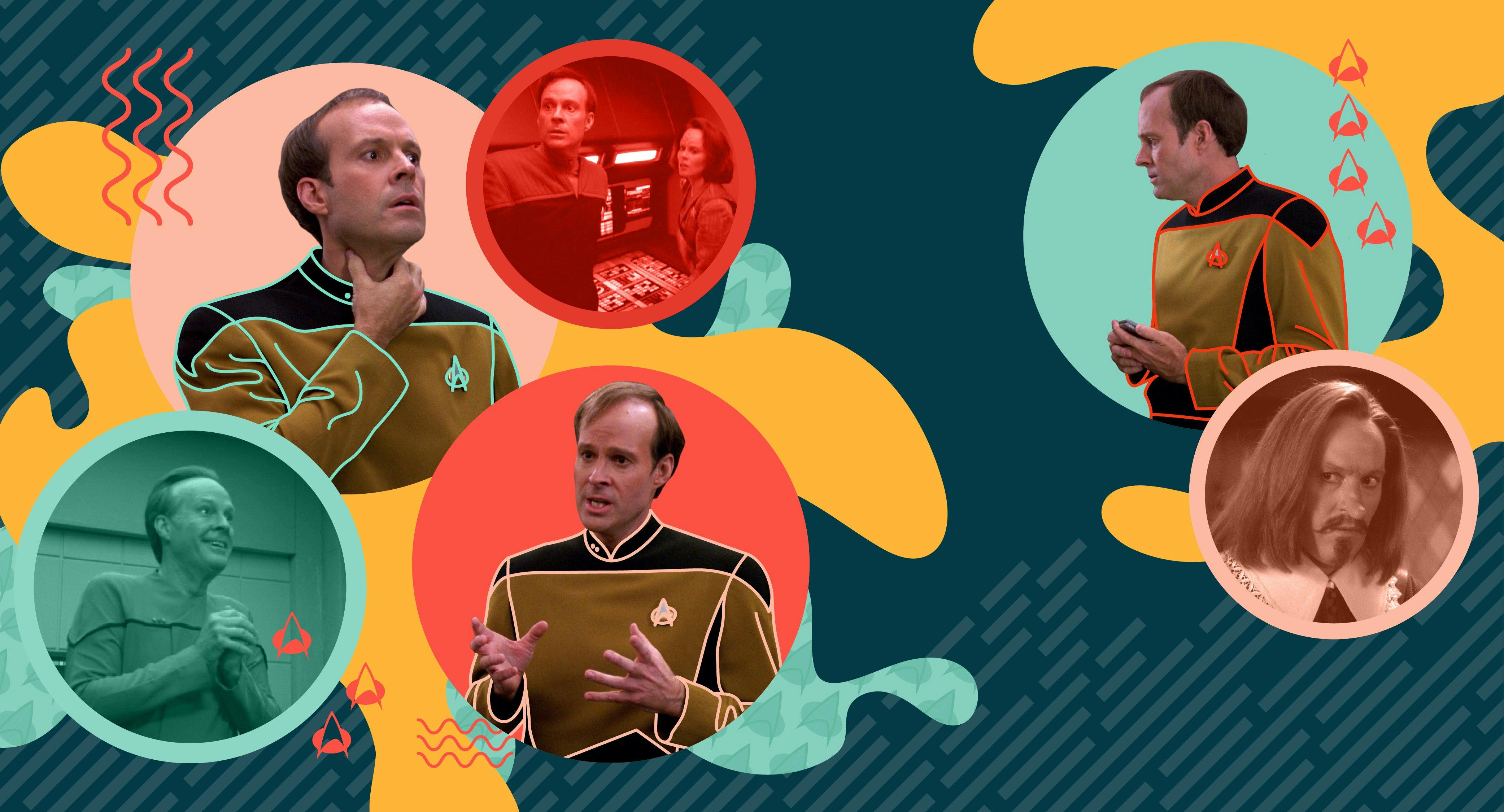
StarTrek.com
Starfleet’s ideals act as its driving force, shaping the future into a utopia where humanity strives for knowledge and self-improvement. The organization itself is filled with passionate and deeply skilled people, all exceptional at their jobs. Star Trek is packed with fantastic role models, and its positive message about hope and optimism for the future makes the show perfect “comfort watching.”
But it was during Star Trek: The Next Generation that Gene Roddenberry reportedly noticed that a certain character type was missing. What if there was someone who just didn’t fit in? Late in the series' third season, the show introduced a new character that would challenge Starfleet, who would later go on to span an 11-year character arc and ultimately be instrumental in getting the U.S.S. Voyager home — Lieutenant Reginald Barclay.
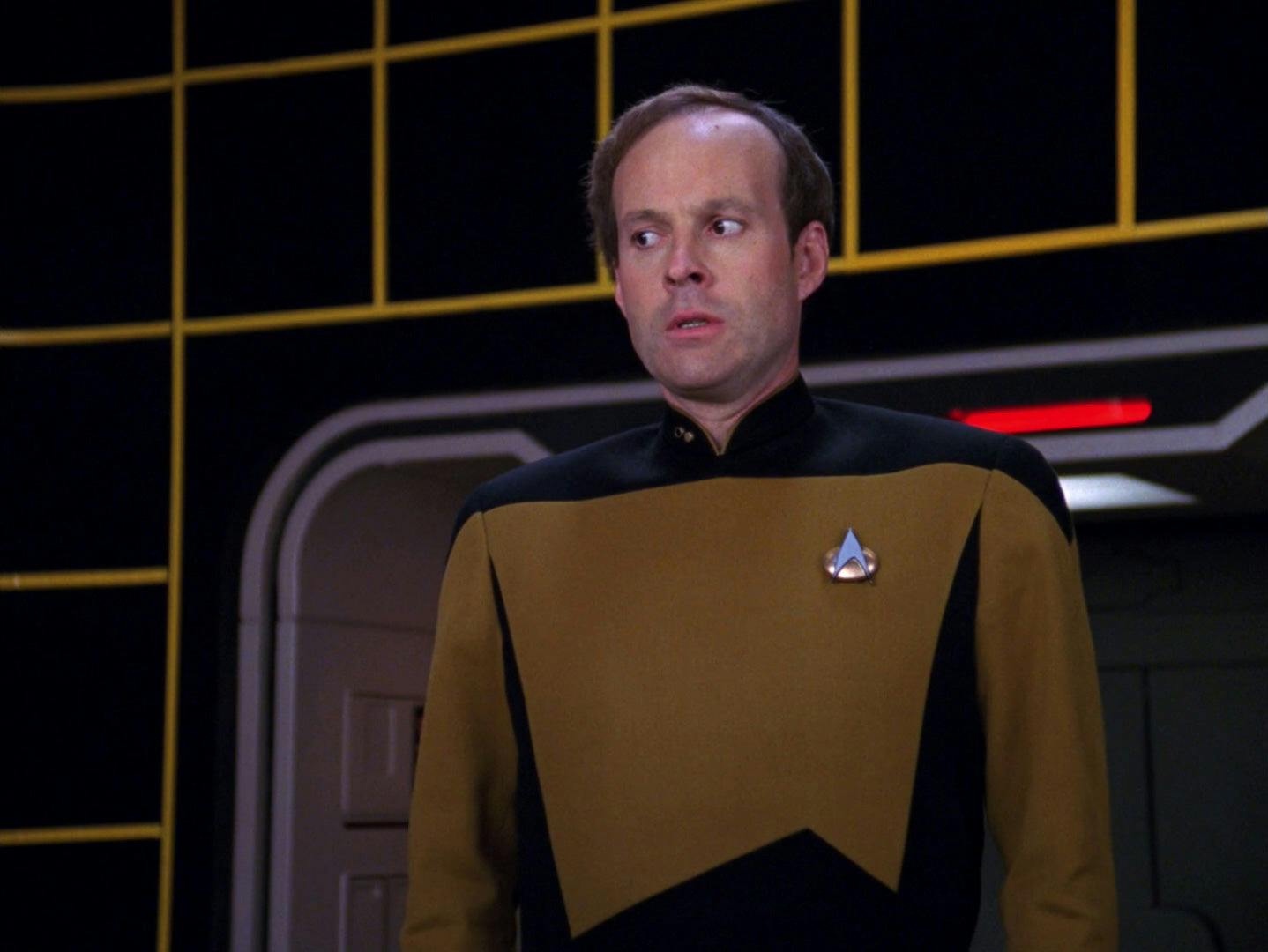
"Hollow Pursuits"
In his debut, “ Hollow Pursuits ,” we see how fellow crew members initially consider Barclay. Early in the episode, Riker and La Forge openly discuss unsatisfactory reports caused by Barclay’s inability to fit in. The officer instinctively shields himself from their view using stacked cargo containers, coming across as neither professional nor subtle. Routinely late, distracted, insecure, he just isn’t what a model officer is expected to be, and the matter is soon escalated to the captain, with Riker adding Barclay’s “seclusive tendencies” at the Academy.
“I guess the question is whether Mr. Barclay is Enterprise material,” Riker says. Instead of transferring Barclay, Picard chooses to give him the chance to show what he can do and urges them to change their attitudes. He’s sympathetic, seeing a common bond, “[He] chose this way of life. He has made the same commitment to Starfleet that we all have.”
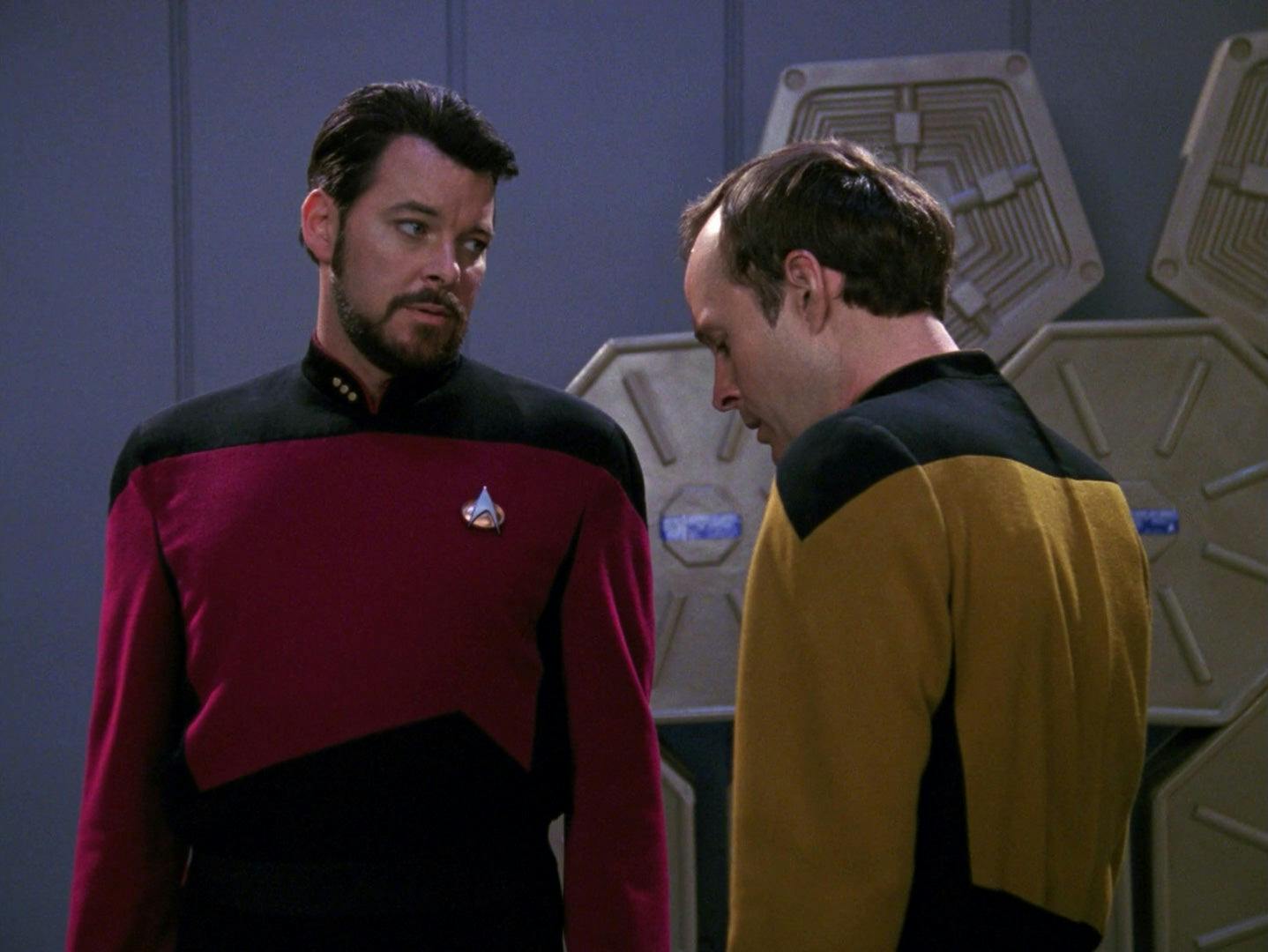
But Starfleet’s rigid expectations don’t disappear overnight. Later in the episode, La Forge reaches out to Guinan for advice. She talks about Barclay’s strengths, but when La Forge says Barclay “just doesn’t fit in here,” Guinan responds with a story about her uncle, whom she describes as “sort of the family misfit.” She says the idea of fitting in repels her. As La Forge continues to complain about Barclay’s faults and nervousness, Guinan says, “If I felt that nobody wanted to be around me, I'd probably be late and nervous too.” We learn about Barclay’s character, how the system deals with people who don’t fit in, and about the pressure of living up to the Starfleet standard. With Picard’s loyalty to individuals who make a commitment to Starfleet, and Guinan’s ability to connect with people, we have two trusted voices countering the adversarial attitude of the senior staff.
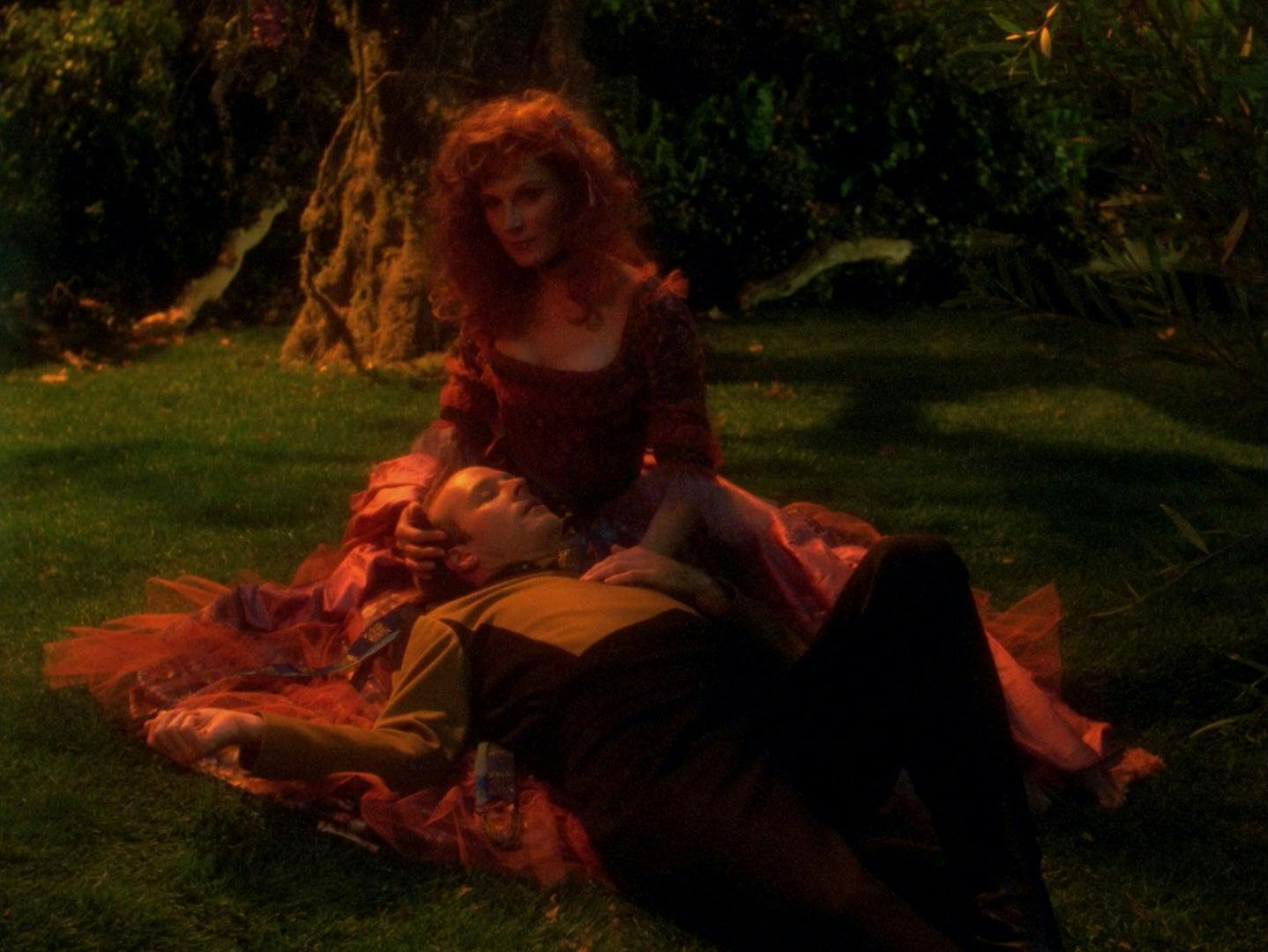
“Hollow Pursuits” also introduces the topic of ‘Holo-addiction,’ although arguably Barclay’s use of the holodeck is less an addiction than a compulsion . Barclay’s mental health isn’t discussed specifically, but his anxiety and inability to move away from fixations may imply OCD to some viewers, where compulsive behavior seeks to relieve anxiety. We see Barclay’s reliance on the holodeck grow, with his programs often featuring the Enterprise crew and himself, the hero of the story.
After discovering one of the programs, La Forge is concerned about Barclay’s actions and opens up about his own experiences with Leah Brahms in “ Booby Trap ." It’s this opening that paves the way for arguably the best and most raw scene of the episode, a defining character moment for Barclay. He’s honest about his trouble fitting in, telling his commander, “Being afraid all the time of forgetting somebody's name, not knowing what to do with your hands. I mean, I'm the guy who writes down things to remember to say when there's a party. And then when he finally gets there, he winds up alone in the corner trying to look comfortable examining a potted plant. 'Just shy.' Sounds like nothing serious, doesn't it? You can't know.”
But it’s at the end of the episode, after being instrumental in helping La Forge identify a threat to the ship, that attitudes begin to change. Confident in his newfound value on the ship and in the relationships that he’s begun to forge, he bids the holographic crew goodbye and deletes the program.

"The Nth Degree"
A year later, in “ The Nth Degree ,” Barclay is now more involved in group activities on the ship, taking part in one of Dr. Crusher’s plays. Troi and Riker, previously wary of Barclay, rush to congratulate him on the progress he’s made in the past year. Troi doesn’t spare the praise, “You used to withdraw onto the holodeck. Look at yourself now. Look at all the other people you're with. You're not just acting, you're interacting. Give yourself some credit.” There’s a noticeable effort being made to include him, and this genuine affection is an ongoing theme throughout the episode.
As a result of an encounter with an alien probe, Barclay becomes increasingly intelligent and competent. But as his confidence turns into arrogance, he gets called on it. In frustration, he argues, “What? Because I'm beginning to behave like the rest of the crew? With confidence in what I'm doing?”
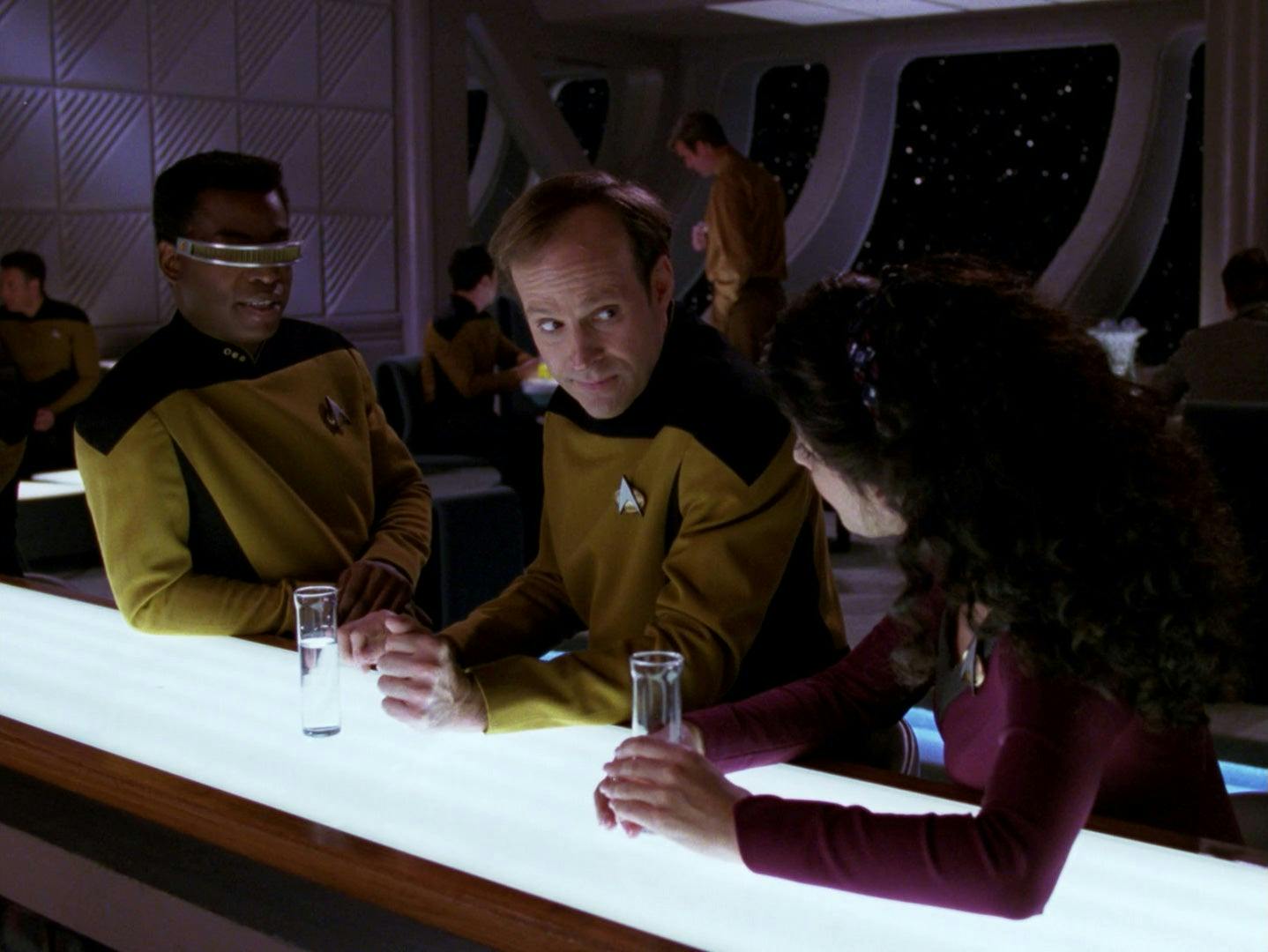
His behavior drives away the friends who have come to genuinely respect him. Even so, Barclay’s empathy and friendship are still obvious. In fact, he sacrifices himself for the crew, although the alien species who sent the probe eventually intervene, saving Barclay’s life. In the closing scene, Barclay is in 10 Forward with La Forge and Troi. He’s returning to normal. His friends sit and support with him as he comes to terms with the past few days. There’s a genuine sense of understanding.
Barclay returns two years later, in “ Realm of Fear .” On an away mission to the U.S.S. Yosemite , an abandoned Starfleet vessel, Chief O’Brien’s warning of a “bumpy ride” is too much for the transporter-phobic Barclay who experiences a panic attack. While Barclay is noticeably more anxious than before, two things reflect the positive changes that the Enterprise has made.
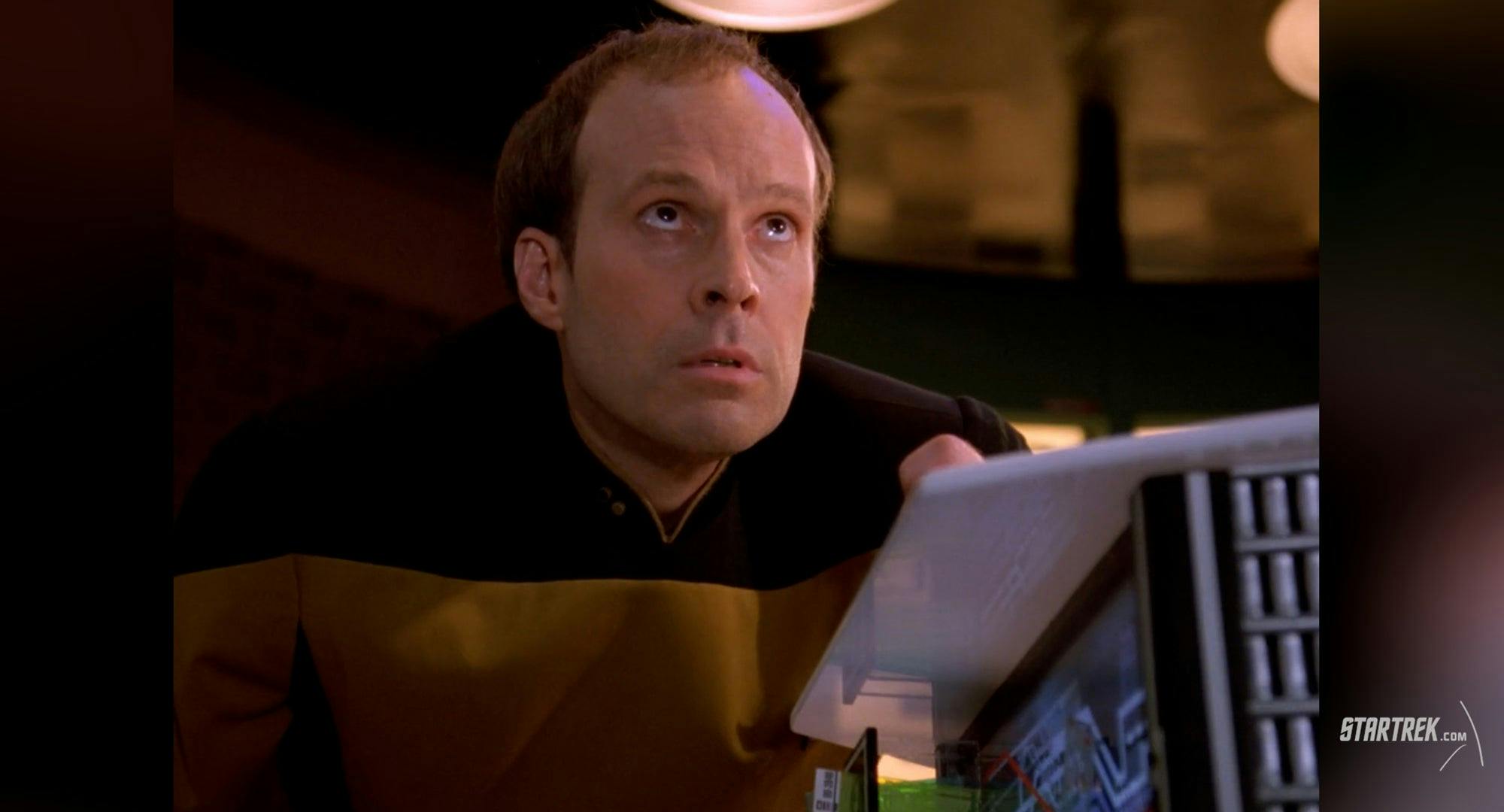
"Realm of Fear"
One of them is how others react to Barclay’s anxieties. O’Brien and Barclay talk about the former’s own fears, solidifying the idea that a model officer isn’t always fearless or confident. Later, when Barclay does beam over and sees a shape in the beam, La Forge and O’Brien help him investigate it. And when Barclay is short and somewhat irrational with the transporter chief, O’Brien recognizes that he’s acting out of anxiety and defuses the situation.
The second demonstration of that positive change is in how the senior staff talk to Barclay. When he steps off the transporter pad on the Yosemite , he’s visibly shaken. A friendly La Forge welcomes him without judgment and Riker also shows Barclay support. No one condemns Barclay for needing time to deal with his anxieties, and they recognize that he managed to take the leap despite deep-seated reservations.
Soon Barclay realizes that there is something trapped in the beam. The matter is taken seriously, not because they have to, but rather because the Enterprise has created an atmosphere where discourse and different viewpoints are welcomed. Barclay’s word is accepted like that of any other Starfleet officer. The crew soon discovers that Barclay’s claim is correct, proving himself instrumental in saving the Yosemite ’s missing crew members.
Eventually, Barclay transfers from the Enterprise to Starfleet Command to work on the Pathfinder project to establish contact with Voyager .
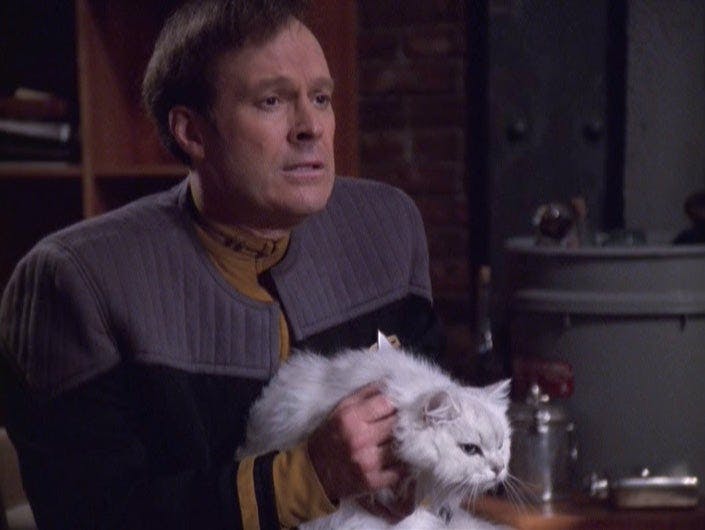
"Pathfinder"
“ Pathfinder ” begins as Barclay walks Troi through the events leading to his dismissal from his latest project and admits that he’s become obsessed with Voyager . His approach is at odds with the rest of the officers on the project. Commander Pete Harkins appreciates Barclay’s dedication to the project, but he doesn’t believe in his plan to create a wormhole that would allow communication with Voyager .
Barclay starts repeating old behavior, having recreated the Voyager crew in the holodeck. But the program is different from the ones he used to run on the Enterprise ; those were an outlet for his frustration. Here, he interacts with a crew who appreciate him. We see how he’s fallen back into old habits, even though he insists he’s working out technical problems. But it’s clear that the simulation isn’t just about his work. He’s lacking friends; ever since he left the Enterprise , Barclay has been struggling to cope. He feels as if he lost his family.
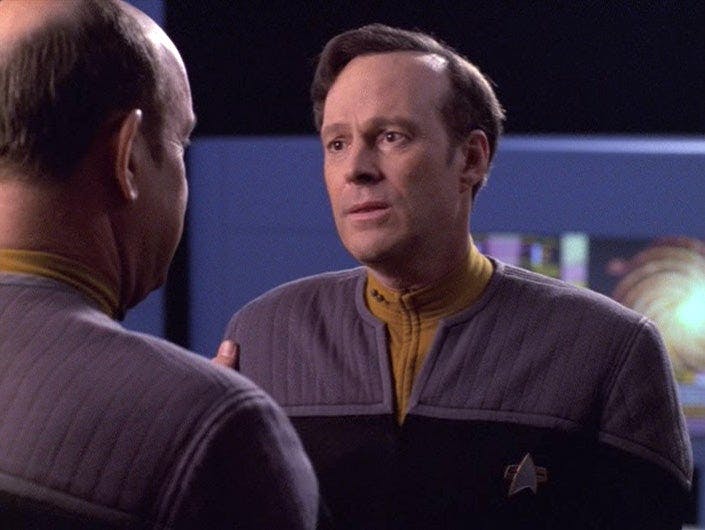
During Admiral Paris’ visit the next day, Barclay mentions his wormhole idea against Harkins’ orders. When Harkins dismisses Barclay’s theory as premature, Barclay loses his temper; he feels they are betraying the people stranded in the Delta Quadrant. Admiral Paris doesn’t take kindly to the implication that he has forgotten about his own son, and Harkins dismisses Barclay for the day.
Whatever support or comfort Barclay may have taken from the Voyager simulation, he was serious about using it for research. Lack of progress caused Harkins to lose faith in Barclay’s suggestions, but with the false support of the holographic Voyager senior staff, Barclay can work whilst feeling like absolute faith has been placed on him.
It’s hard for Starfleet to see this in a positive light. When Harkins discovers what Barclay has been up to, it raises concerns about his mental health, but before Barclay can be removed from the project, a transmission from Voyager is received. The connection is brief, but it’s enough for the Admiral to talk to his son, and to let them know that Starfleet is going to bring them home.
Harkins credits the achievement to Barclay, and lightyears away in the Delta Quadrant, Voyager celebrates their new “honorary member of the Voyager crew.” The Doctor talks about Barclay’s colorful career and unusual medical history, but Janeway sums it up, “Well, whatever his problems, he certainly came through for us.”
In Star Trek: Voyager 's final season, Starfleet attempts to transmit a holographic version of Barclay to Voyager in order to help create a geodesic fold in space that would allow them to reach Alpha Quadrant. However, the transmission is hijacked by the Ferengi. Far more confident and self-aware than its creator, the hologram mingles easily with the Voyager crew. In fact, the personalities are so different that Barclay is considered to be completely separate from the hologram. Or as Kim puts it, “Hope [the real Barclay is] not too shy. He's going to have a 150 new friends when we get back home.”
Back on Earth, on the Pathfinder project, Barclay is trying to figure out why the transmission abruptly ended. In frustration, Barclay seeks out Troi; it’s with the counselor and the admiral’s support that Barclay ends up ultimately saving Voyager .

"Endgame"
We last see Barclay in Voyager ’s finale, “ Endgame ,” set both in the present day and 26 years into the future. In the future, he’s gathered with his “adopted” family as they celebrate the 10th anniversary of their return to the Alpha Quadrant. There’s a real sense of long-lasting friendships and a boost in confidence that comes from being among equals. We also learn that Barclay is one of the few friends who continues to visit Tuvok regularly. So, when Admiral Janeway asks for his help on a clandestine mission, there’s a genuine sense of trust. He offers to go with her, knowing that it may be a one-way trip, but she turns him down. She thanks Barclay, saying she wouldn’t have been able to do this without him, her statement genuine and heartfelt.
Barclay’s character grows throughout The Next Generation and Voyager , as he finds new things that ground him and give him confidence. In that glimpse of the future, we see that he has flourished, surrounded by the friends that returned to him from the Delta Quadrant, brought home in great part by his determination. The guidelines, achievements, and sense of direction Starfleet provides to its people often failed this competent and passionate officer. He represents aspects of humanity that are easily overlooked or lost. Originally a candidate for a transfer off the Enterprise , he makes a difference time and time again. He was enabled by his fellow officers’ efforts to create an open and welcoming atmosphere. Even when his superiors didn’t take the time to listen, that didn’t stop Barclay. He was driven to understand a situation fully in order to help others.
Starfleet is rigid in its structure, and it needs to be in order to be able to sustain itself. Someone like Barclay doesn’t fit their definition of a “model officer,” and Barclay isn’t one. Even so, he is invaluable.
Get Updates By Email
This article was originally published on March 5, 2021.
Based in London, Rachel Perkins (she/her) is a writer with a passion for Star Trek, video games, cats, and Nancy Drew. She can often be found writing for The Sudden Stop and Positively Tomb Raider. Find her on Twitter @JadenRachel.

Star Trek: The Next Generation (TV Series)
The nth degree (1991), dwight schultz: barclay.
- Photos (11)
- Quotes (13)
Photos

Quotes
Barclay : Computer, begin new program. Create as follows: workstation chair. Now, create a standard alphanumeric console, positioned for the left hand. Now an iconic display console, positioned for the right hand. Tie both consoles into the Enterprise main computer core, utilizing neural-scan interface.
Enterprise Computer : There is no such device on file.
Barclay : No problem. Here's how you build it.
Commander William T. Riker : [after Barclay has managed to raise the shield strength by 300%] Mr. Barclay! Everyone's still trying to figure out exactly how you did it.
Barclay : Well, it... it just occurred to me that I could set up a frequency harmonic between the deflector and the shield grid, using the warp field generator as a power flow anti-attenuator, and that, of course, naturally created an amplification of the inherent energy output.
Commander William T. Riker : [clueless] U-huh, I see that...
Lt. Commander Geordi La Forge : Reg, ever since our run-in with that probe, something's different about you.
Barclay : What? Because I'm beginning to behave like the rest of the crew? With confidence in what I'm doing?
Lt. Commander Geordi La Forge : You just spent the entire night arguing grand unification theories with Albert Einstein!
Barclay : The Cytherians are exploring the galaxy, just as we are. The only difference is that they never leave their home. They bring others here. Their only wish: an exchange of knowledge. They want to know us!
[last lines]
[Barclay analyzes a chess game and makes the next move]
Barclay : Checkmate in nine moves.
[he rejoins Troi for a walk]
Counselor Deanna Troi : I didn't know you played chess.
Barclay : I don't.
[Barclay is back to his old self]
Counselor Deanna Troi : So how much do you remember?
Barclay : I - I remember doing everything. I just don't remember how or why.
Counselor Deanna Troi : How do you feel now?
Barclay : Smaller.
Lt. Commander Geordi La Forge : Just plain old Barclay, huh?
Barclay : Always seems to come back to that, doesn't it?
Barclay : Wouldn't you like to take a walk with me through the arboretum? The zalnias should be in bloom.
Counselor Deanna Troi : Reg, as your former counselor, I don't think it would be appropriate.
Barclay : I don't need a counselor. What I need is the company of a charming, intelligent woman.
Counselor Deanna Troi : [indulgent] Good night, Mr. Barclay.
Barclay : I've finally become the person I've always wanted to be. Do we have to ask why?
Lt. Commander Geordi La Forge : Yeah, I think we do.
Barclay : I perceive the universe as a single equation, and it is so simple!
Barclay : The moon, yes, that'll be my home, my... Paradise. I shall find there all the souls that I love: Socrates, Galileo... And when I arrive, they will question my worthiness. "What the devil is *he* doing there among us?" Philosopher, scientist, poet, musician, duellist! Here lies Hercule Savinien De Cyrano de Bergerac!
[to Beverly, as Roxane]
Barclay : I would not have you weep any less for that charming, good and handsome Christian. I only ask this: that as the great cold surrounds my bones, you allow a double meaning for your mourning veil. And when you let fall your tears for him, some few will be... for me.
Doctor Beverly Crusher : [blinking away tears] ... That was a real improvement.
Doctor Beverly Crusher : [analyzing Barclay's brainpower] I couldn't even guess at your IQ level now.
Barclay : Probably somewhere between 1200 and 1450.
Doctor Beverly Crusher : But that isn't all. The corpus callosum, the connecting bridge between both sides of the brain? It is so active now that the hemispheres are essentially behaving as one.
Lt. Commander Geordi La Forge : So it's not just raw intelligence we're talking about here?
Doctor Beverly Crusher : No. Creativity, resourcefulness, inspiration, imagination, they've all been enhanced. Lieutenant - you could very well be the most advanced human being who has ever lived.
Counselor Deanna Troi : Reg, you've frightened all of us. I'm sure that wasn't your intent.
Barclay : Young children are sometimes frightened of the world. That doesn't mean that their parents should let them stay in their cribs.
Barclay : Trust me!
Release Dates | Official Sites | Company Credits | Filming & Production | Technical Specs
- Full Cast and Crew
- Release Dates
- Official Sites
- Company Credits
- Filming & Production
- Technical Specs
- Plot Summary
- Plot Keywords
- Parents Guide
Did You Know?
- Crazy Credits
- Alternate Versions
- Connections
- Soundtracks
Photo & Video
- Photo Gallery
- Trailers and Videos
- User Reviews
- User Ratings
- External Reviews
- Metacritic Reviews
Related Items
- External Sites
Related lists from IMDb users

Recently Viewed
The Nth Degree (Star Trek: The Next Generation)
19th episode of the 4th season of star trek: the next generation / from wikipedia, the free encyclopedia, dear wikiwand ai, let's keep it short by simply answering these key questions:.
Can you list the top facts and stats about The Nth Degree (Star Trek: The Next Generation)?
Summarize this article for a 10 year old
" The Nth Degree " is the 93rd episode of the American science fiction television series Star Trek: The Next Generation , and the 19th episode of the fourth season .
Set in the 24th century, the series follows the adventures of the Starfleet crew of the Federation starship Enterprise-D .
Rob Legato directed and oversaw visual effects for the episode. He created a 3-D effect where the Cytherian's huge head appears to pop out of the screen, allowing him to have a face-to-face conversation with Picard.

- Starfleet Academy personnel
- Starfleet operations personnel
Reginald Barclay
- View history
Lieutenant Reginald Endicott Barclay III (often referred to as " Reg ") was a highly talented Human Starfleet systems diagnostic engineer who lived in the 24th century . In his early days aboard the Enterprise -D, he frequently displayed nervous behavior, demonstrated a noticeable lack of confidence, stammered frequently, was extremely introverted, and occasionally bumbled. These traits aroused the derision of some of his shipmates on the USS Enterprise -D – with some even going as far as calling him "Lieutenant Broccoli " behind his back or, on unfortunate occasions, to his face.
- 1.1 The Enterprise -D
- 1.2 Jupiter Station
- 1.3 The Enterprise -E
- 1.4 The Pathfinder Project
- 2.1.1 The Enterprise -D
- 2.1.2 Pathfinder
- 3.1.1 Geordi La Forge
- 3.1.2 Lewis Zimmerman
- 3.1.3 Deanna Troi
- 3.1.4 The Doctor
- 3.1.5 Pete Harkins
- 3.2 Romances
- 4 Alternate realities and timelines
- 5 Holograms
- 6 Memorable quotes
- 7.1 Appearances
- 7.2.1 Origins
- 7.2.2 Casting
- 7.2.3 Portrayals
- 7.2.4 Reception
- 7.3 Apocrypha
- 7.4 External links

Starfleet career [ ]
During Barclay's attendance at Starfleet Academy , his "seclusive tendencies" escaped the attentions of neither his classmates nor his service record. Despite this, Barclay graduated and received a commendation by serving competently in Starfleet for many years . During his service aboard the USS Zhukov , he earned satisfactory ratings , and when he transferred to the Enterprise -D the Zhukov 's commanding officer , Captain Gleason , spoke highly of Barclay to his new ship's crew. ( TNG : " Hollow Pursuits ")
The Enterprise -D [ ]
Upon his transfer to the Enterprise -D in 2366 , Barclay held the rank of lieutenant junior grade .
Due to his nervousness and lack of confidence, many members of the Enterprise crew initially referred to him as "Lieutenant Broccoli ", a play on his surname, coined by Wesley Crusher . He was initially disliked by members of the crew, not only due to the fact he seemed constantly nervous and on edge, but also because he was routinely late for duty and often wound up on report for seemingly not performing to the best of his ability. As a result, he was given an 'unsatisfactory' rating in his evaluation. Riker and La Forge attempted to get him transferred off the ship, not believing he was competent enough to serve on the Federation flagship (with Riker even suggesting that Captain Gleason had exaggerated his assessment of Barclay to hasten the departure of a troublesome officer). Captain Picard, however, refused to simply transfer him away from the ship, and it was because of Picard's support and Geordi La Forge's encouragement (at Picard's behest) that Barclay's confidence began to increase. ( TNG : " Hollow Pursuits ")
During the first major Borg incursion into the Federation in late 2366, Barclay worked on repairs with Sherbourne after the Enterprise -D crew, in an unsuccessful attempt to destroy the Borg cube , emitted a burst of energy from their ship's deflector dish . ( TNG : " The Best of Both Worlds, Part II ")
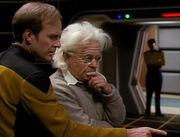
Barclay corrects Albert Einstein
As time passed, Barclay slowly grew in confidence and became one of La Forge's best engineers. Following an encounter with an alien probe in 2367 , Barclay's IQ rose to somewhere between 1200 and 1450 as a result of a neurological enhancement he received from the probe. During the time he possessed this enhanced intellect, Barclay was more confident, outgoing, and sure of himself – even arguing grand unified theories with a hologram of Albert Einstein on the holodeck . Barclay was able to use the holodeck to integrate his mind into the ship's computer , effectively taking complete control . Unknown to Barclay, the Cytherians (the creators of the probe) set this in motion so that he would bring the Enterprise -D to them, as this was their species' preferred method of investigating new races. All attempts to disconnect or dissuade him were unsuccessful, and he created a subspace distortion that brought the Enterprise -D to the Cytherians. After this encounter, Barclay was returned to his previous self, but he did retain a bit of the confidence and intelligence that the experience gave him. ( TNG : " The Nth Degree ")
In 2369 , Barclay assisted Alexander Rozhenko with writing a holodeck program of Deadwood , South Dakota in the Ancient West . Barclay included a prostitute and brothel in the simulation (likely forgetting it was to be a child's program), which Lieutenant Worf did not appreciate for his son's sake. ( TNG : " A Fistful of Datas ")
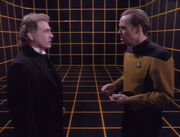
Barclay speaks with the Moriarty hologram
Later that year, Barclay inadvertently released the holographic representation of Professor James Moriarty from his confines in the computer memory core of the Enterprise -D, while conducting a diagnosis of a failure of the holodeck matrix diodes , which turned out to have been caused by Moriarty himself. Upon activation, Moriarty briefly explained his history to Barclay and, realizing that over four years had passed, deduced that Captain Picard had merely promised to research a way for him to live in the real world in order to get him to release a hostage he had taken at the time. Barclay defended Picard, saying the captain would never go back on his word, and promised to report the incident to his superiors, which he did.
Barclay, Picard, and Data then reactivated the program to speak to Moriarty, who expressed his desire to leave the holodeck. Barclay proposed using transporter pattern enhancers to beam Moriarty off the hologrid and into the "real world." This idea, however, was a ruse by Moriarty to trick the three officers into giving him control of the ship by use of a holographic simulation of the Enterprise -D within the Sherlock Holmes program. The failure of the experiment led Data to discover the trickery, and on Captain Picard's suggestion he and Barclay managed to create a separate simulation within both programs, thereby fooling Moriarty with his own plan. Thinking he was free, Moriarty relinquished control of the Enterprise , allowing Barclay to store his program in an enhancement module , where Morirarty could safely explore the galaxy without causing any further trouble.
Barclay, along with the senior staff, later convened in the observation lounge to discuss recent events, and Captain Picard instructed him to keep the module safe. Picard also jokingly wondered if their reality " might be nothing more than an elaborate simulation being run inside a little device… sitting on someone else's table, " which prompted Barclay, after the meeting had concluded, to test the idea by ordering the computer to "end program." Satisfied his life wasn't a simulation when nothing happened, he picked up the module and left as well. ( TNG : " Ship In A Bottle ")
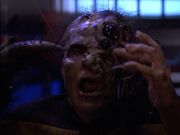
A "devolved" Reginald Barclay
The following year , Barclay had the dubious honor of becoming the eponymous person for a new illness, " Barclay's Protomorphosis Syndrome ". He, in common with the rest of the crew, became affected when a treatment for the mild Urodelan flu provided by Doctor Beverly Crusher activated one of Barclay's recessive genes, causing him to mutate into a spider-like creature. It was due only to the efforts of Captain Picard and Lieutenant Commander Data that Barclay and the rest of the crew were saved; as Picard and Data were off the ship when the incident occurred, they were able to develop a retrovirus and release it using the ventilation systems. As Barclay was the first-known patient of the disorder, Dr. Crusher decided to name the newly discovered illness in his honor. ( TNG : " Genesis ")
In 2375 , Lieutenant Commander Worf and Chief O'Brien specifically mentioned that nobody could forget Barclay when remembering old friends on the Enterprise . O'Brien and Worf remembered him most for his extravagant "Three Musketeers" program that he often invited the crew to join him in. ( DS9 : " Image in the Sand ")
Jupiter Station [ ]
In 2371 , the USS Voyager 's EMH became trapped in a malfunctioning holodeck programe and encountered a simulation of Barclay, who claimed they were on Jupiter Station and that The Doctor was Dr. Lewis Zimmerman and Barclay was his assistant. At another point, the Doctor believed himself to be in Voyager 's sickbay, where a simulation of Harry Kim claimed that Barclay had been assigned to test the The Doctor's interpersonal skills. ( VOY : " Projections ")
Sometime between 2371 and 2376 , Barclay was promoted from lieutenant junior grade to lieutenant . ( VOY : " Projections ", " Pathfinder ")
The Enterprise -E [ ]

Barclay exchanges a handshake with Zefram Cochrane
Barclay was assigned to the new USS Enterprise -E before the Battle of Sector 001 in 2373 . He traveled into the past with the rest of the ship's crew to the day before Earth 's First Contact with the Vulcans and met the noted inventor Dr. Zefram Cochrane . Barclay was thrilled at the opportunity to shake Cochrane's hand, so much so, in fact, that Lieutenant Commander Geordi La Forge found himself having to remind Barclay to calm down and continue his work, helping Cochrane repair the Phoenix . Barclay also obtained La Forge's approval and input on a makeshift component that Barclay and other engineers from the Enterprise -E intended to use to replace the Phoenix 's warp plasma conduit . ( Star Trek: First Contact )
The Pathfinder Project [ ]
In 2374 , Barclay was transferred to the Pathfinder Project at Starfleet's Communications Research Center , endeavoring to return Voyager to the Alpha Quadrant from the distant Delta Quadrant . As a result, Barclay relocated to Earth and kept an apartment in San Francisco . Barclay created a holographic recreation of the vessel and its crew to enable him to experiment with different solutions.
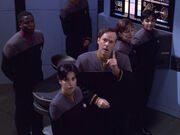
Barclay explains his idea to Admiral Paris
Later that year, Barclay, with the assistance of The Doctor , devised the idea of using the MIDAS array to direct a tachyon beam towards an approaching class B itinerant pulsar , thus generating an artificial micro-wormhole . This wormhole could then be directed towards Voyager 's likely locations and used to communicate with the ship. Unfortunately, Commander Pete Harkins turned down his idea as impractical.
However, Barclay was unable to contain his enthusiasm during an inspection of the research facility by Admiral Paris . This prompted Harkins to send Barclay home for the rest of the day. Barclay disobeyed and instead returned to his simulation to refine his ideas. When Harkins later discovered him in the simulation, Barclay was suspended pending a psychological evaluation, as the Commander believed Barclay had suffered a relapse of his holo-addiction.
Barclay was unable to accept this and appealed to Admiral Paris, then broke into the communications center. He attempted to go forward with his plan, but was discovered. To prevent himself from being interrupted, Barclay activated the holographic recreation of Voyager , using the holographic crew to protect and assist him. Just as Harkins used a simulated warp core breach to end the program, Captain Kathryn Janeway hailed the Communications Center from the Delta Quadrant, having received Barclay's message. With this (albeit brief) two-way communication with the ship, ship's logs, research data, a personal message for Tom Paris from his father and instructions in order to improve the communication systems of Voyager were able to be transmitted, and Barclay's ideas were vindicated. The crew of Voyager later toasted their unmet hero who had established the link, honoring Barclay as an honorary member of the crew. ( VOY : " Pathfinder ")
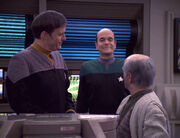
Barclay with Lewis Zimmerman and The Doctor
In 2377 , Barclay found a way to use the MIDAS array to transmit a data stream to Voyager once a month, allowing Starfleet to send the crew information and letters from home. He later returned to Jupiter Station with Voyager 's EMH, who had been transmitted to the Alpha Quadrant using the connection. Barclay had informed The Doctor that his creator, Doctor Zimmerman, had been diagnosed with acute subcellular degradation and was dying. Although Zimmerman initially refused The Doctor's assistance, Barclay – who had also enlisted the aid of Counselor Deanna Troi – helped The Doctor persuade Zimmerman to realize that The Doctor's assistance was the best course of action to save his life. ( VOY : " Life Line ")
Later that year, Barclay (possibly inspired by The Doctor's trip to the Alpha Quadrant) attempted to send a hologram to Voyager in order to assist the crew. This failed when the hologram disappeared, costing Voyager 's crew that month's data stream. Barclay later discovered that a romantic acquaintance of his, Leosa , had been using him to gain information on Voyager and the Pathfinder project. It turned out the information she had obtained was sold to a group of Ferengi who had used it to alter the holographic program Barclay sent to Voyager , with instructions to kill the crew and reprogram the shields to withstand a geodesic fold they had created between the Alpha and Delta Quadrants. Even though their plan was to steal the Borg technology in Seven of Nine 's body (which was worth a fortune in latinum ), Barclay, with the help of Counselor Troi, was able to deceive the Ferengi into abandoning their plan, thereby saving Voyager . ( VOY : " Inside Man ")
In 2378 , Barclay created the first-ever transgalactic com link when he used a quantum singularity to establish daily (if brief) real-time contact with Voyager, an incredible achievement. Later he informed Admiral Paris that a draft version of the holonovel Photons Be Free , written by The Doctor, had been released early, becoming popular in thousands of holosuites across the Federation. Barclay was present during a hearing to decide The Doctor's rights as the creator of the work. ( VOY : " Author, Author ")
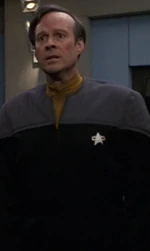
Barclay at the time of Voyager 's return
Later that year, Barclay was on duty at the Communications Center when long-range sensors detected a Borg transwarp conduit opening just outside the Sol system . He quickly reported this information to several visiting admirals. When a Borg sphere emerged from the transwarp conduit and exploded to reveal Voyager , Barclay was one of the first to welcome the starship's crew home. ( VOY : " Endgame ")
Medical and psychological record [ ]
Barclay suffered from severe transporter phobia , although he later overcame this psychological barrier. ( TNG : " Realm Of Fear ") He was also hypochondriac and prone to self-diagnosis; once, he thought himself to have transporter psychosis , and on another occasion, he believed himself to have Terellian Death Syndrome (both ultimately untrue). ( TNG : " Genesis ")
Struggle with holo-addiction [ ]
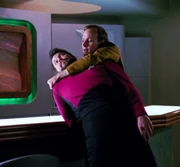
Barclay threatens the Riker hologram
Sometime prior to 2366, Barclay began to suffer from holo-addiction, becoming addicted to the fantasy worlds and stories the holodeck could create. This addiction continued after he transferred to the Enterprise -D, and he had a tendency to spend more time inside the holodeck, where he was more confident and comfortable, than in real-life social situations. Unlike in normal holoprograms, Barclay used the likenesses of the Enterprise 's senior staff to create unusual scenarios in which he was the hero.
One of his programs was an exact recreation of the Enterprise -D, in which he often argued with and talked back to senior officers without any fear of consequences. In one holodeck session he propelled the holographic representation of Geordi La Forge across Ten Forward and threatened First Officer William Riker, in an attempt to impress the holographic Deanna Troi.
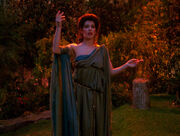
The "Goddess of Empathy"
Another recreation of Barclay's was entitled " Barclay Program 15 ". In this scenario, he engaged in sword fights with " The Three Musketeers ", holograms that resembled Jean-Luc Picard, Geordi La Forge, and Data; romanced the " Goddess of Empathy ", a representation of Deanna Troi; and relaxed with a hologram of Beverly Crusher. Barclay had also created an effigy of William Riker that was an extremely short, bumbling swordsman.
When Barclay's holo-addiction was discovered, Commander Riker was particularly annoyed with him and wanted to delete all programs in which he had used the crew's physical appearances. Counselor Troi objected, as it gave them valuable insight into what was troubling Barclay, but upon seeing the "Goddess of Empathy" she became equally angry (to Riker's amusement; he in turn prevented her from deleting the Goddess for the same reason).
Barclay managed to overcome his addiction with the help of Geordi La Forge. When the Enterprise was in danger of flying herself apart due to an invidium infection of the computer systems, La Forge encouraged Barclay's imagination, and it was he who discovered the infection, which led to the situation being controlled. After a few words from La Forge, Barclay returned to the holodeck and deleted all of his holoprograms but one: Barclay Program 9 . The crew soon came to realize he was as important as anyone else on the ship. ( TNG : " Hollow Pursuits ", " The Nth Degree ")
Pathfinder [ ]
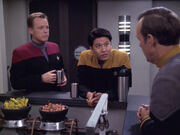
Barclay jokes with a holographic Tom Paris and Harry Kim
In 2376 Barclay became obsessed with attempts to return Voyager from the Delta Quadrant and expressed an interest in becoming involved in the Pathfinder Project. Barclay came dangerously close to suffering a relapse of his holo-addiction later that year, when he used the program that recreated the crew of Voyager . Although it began as a tool to test different theories on how to contact the stranded ship, he quickly came to regard the program as another sanctuary, away from the real world.
The program was only semi-accurate; because of his programming, the duplicates of Voyager 's crew all liked and relied upon him, and treated him as their best friend. He joked with Harry Kim, played poker with the senior staff, enjoyed hoverball with Tom Paris, and assisted B'Elanna Torres with warp core calibrations. He even got a massage from The Doctor on one occasion. Barclay once told Deanna Troi that he slept better in his holographic quarters than he ever did in his apartment.
The fascination with Voyager that Barclay had developed, as well as his unauthorized interactions with the holographic crew, expedited his dismissal from the Pathfinder Project. However, once Barclay used the program to prove his theory correct, the time he spent in the Voyager simulation dwindled, along with his need for the holodeck. ( VOY : " Pathfinder ", " Life Line ", " Inside Man ", " Author, Author ")
Personal life [ ]
Reginald Barclay was known for his cheese omelets . ( VOY : " Pathfinder ")
Friendships [ ]
Geordi la forge [ ].
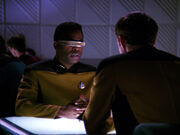
La Forge gets to know Barclay
Geordi La Forge was initially Barclay's superior officer on the Enterprise -D. When he first came aboard, La Forge remarked that Barclay was " always late, never gives his best effort, just slides by. " After being instructed by Captain Picard to find a way to integrate him into the crew, however, La Forge began to encourage Barclay and praise him for his efforts.
On the subject of his holo-addiction, La Forge tried to make Barclay feel as though he could interact with the crew and didn't have to confine himself to the holodeck. Barclay once said that he thought La Forge was the most real to him of any of the crew.
Eventually, La Forge came to respect him for his technical knowledge and Barclay became a valued part of the Enterprise engineering crew. ( TNG : " Hollow Pursuits ")
This cooperation carried over to the Enterprise -E, where Barclay continued to serve under La Forge. When the ship traveled back in time to 2063, Barclay's meeting with Zefram Cochrane was supervised by La Forge. ( Star Trek: First Contact )
In February 2377 , Barclay attended La Forge's birthday party and showed him the specifications for a hologram he planned to send to the USS Voyager in the Delta Quadrant . La Forge told Barclay he was proud of him. ( VOY : " Inside Man ")
Lewis Zimmerman [ ]
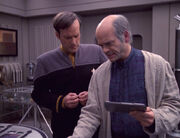
Barclay visits Zimmerman on Jupiter Station
Barclay first met Lewis Zimmerman while working on development of the EMH Mark I in 2371. The two of them later developed a mutual respect, Barclay being instrumental in the forging of Zimmerman's friendship with The Doctor.
When Zimmerman believed he was reaching the end stage of his terminal illness, he included Barclay in his last will and testament , giving him his collection of holographic art including the " Woman in Four Dimensions " piece. In addition, Zimmerman requested that Starfleet allow Barclay to complete his Trojan Horse Project , as he trusted Barclay to be the only engineer that would get it done. ( VOY : " Projections ", " Life Line ")
Deanna Troi [ ]
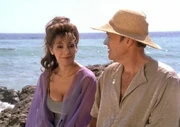
Barclay consults Deanna Troi on his suspicions about Leosa
Barclay met Counselor Troi during his time on the Enterprise -D and quickly developed an attraction to her, even going as far as to use her image in one of his holoprograms, featuring her as his lover. ( TNG : " Hollow Pursuits ")
Barclay's feelings for her soon became merely professional respect, however, and she continued to provide support to him in the form of counseling and friendship. ( ENT : " These Are the Voyages... ")
In 2376, at Barclay's request, she visited him to discuss his feelings about his new assignment at Starfleet's Communications Research Center. He opened up to her, noting that work at the CRC was nothing like being on the Enterprise , where there was a feeling of family. ( VOY : " Pathfinder ")
As a favor to Barclay, Troi asked Captain Jean-Luc Picard for leave from the Enterprise to convince Lewis Zimmerman to accept treatment from Voyager 's EMH and assisted Barclay with a ruse to disrupt The Doctor's programming, saying, " Traditional therapy wasn't getting [them] anywhere. " ( VOY : " Life Line ")
In 2377 she again helped Barclay by influencing him to realize that Leosa was using him to gain information on Voyager and encouraged him to report it to his superiors. Troi later invited him on a double date with her, Commander Riker, and a real teacher friend of his called Maril as a way for him to get out and meet people. ( VOY : " Inside Man ")
The Doctor [ ]
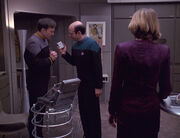
Barclay convinces The Doctor to stay and help Zimmerman
During a severe malfunction, one of The Doctor's recurring delusions was Barclay, who tried to convince him that he was in fact Lewis Zimmerman and that he was trapped in a holographic Voyager . In order to end the simulation, "Lewis" had to destroy the warp core. Fortunately, a delusion of Chakotay convinced him otherwise. The Chakotay hallucination claimed that Barclay was part of the team that created him. ( VOY : " Projections ")
Barclay first met The Doctor when he took him to Jupiter Station to help Dr. Zimmerman, though the two had previously corresponded via the communication system he developed using the MIDAS array. It was Barclay who had informed The Doctor of Zimmerman's illness, and it was he who initially convinced him to stay and treat Zimmerman, even when he refused all help. ( VOY : " Life Line ")
When Voyager received the altered Barclay hologram, The Doctor realized something was wrong with the program, stating that the real Barclay never exhibited rude and careless traits as he had observed in the hologram. ( VOY : " Inside Man ")
During The Doctor's hearing to decide his rights as a hologram Barclay defended him, recounting how he had " traveled halfway across the galaxy " to care for Dr. Zimmerman. He compared it to a son showing his "old man" what he had become so he could be proud of him. When it was ruled that The Doctor had the right to control his own work, Barclay congratulated him. ( VOY : " Author, Author ")
Pete Harkins [ ]
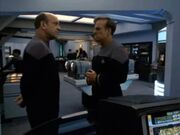
Harkins orders Barclay to take some leave
Commander Pete Harkins was Barclay's superior officer on the Pathfinder Project. He once invited Barclay to dinner with his wife, Angie , and her sister with the aim of setting the sister up with Barclay; refused, preferring to concentrate on his work.
Although he believed Barclay to be a competent engineer, Harkins was skeptical of some of his theories, in part due to Barclay's history. When Barclay developed the idea to use the MIDAS array to create an artificial singularity to Voyager , Harkins dismissed it as a "cock-eyed theory" that only existed in his head and ordered him to abandon the idea. Determined to prove his theory right, Barclay bypassed Harkins and went straight to Admiral Paris. This caused their previous relationship to deteriorate.
Harkins later discovered that Barclay had recreated the Voyager crew on the holodeck. He believed he had been a friend to Barclay by allowing him some leeway, but upon finding him there and realizing his past history of holo-addiction, he pulled him off the project and told him to get counseling.
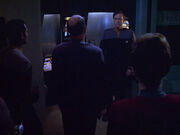
Harkins forces Barclay to end the Voyager simulation
Barclay initially followed Harkins' instructions and went home, where he talked about the situation with Deanna Troi. Later the same night, he decided to disobey Harkins' orders, breaking into the Pathfinder lab and accessing the MIDAS array in an attempt to prove this theory correct. When Harkins discovered Barclay in the lab, he ordered Security to apprehend him, but Barclay activated the Voyager scenario and locked out all holodeck controls. He continued with this plan to send a message to Voyager from within the simulation and used the holographic characters to stop the security officers. Harkins eventually managed to apprehend him by initiating a warp core breach in the simulation, forcing Barclay to close it down.
Harkins then arrested Barclay for breaking into the lab and using equipment without authorization. But before the security officers could take him away, a message came through from Voyager . Barclay's plan had worked. Harkins subsequently apologized for doubting him. ( VOY : " Pathfinder ")
After Barclay tried to send his hologram to Voyager , he became obsessed with finding the reason why it had failed to reach them, even blaming the Borg and the Romulans for intercepting the message. Harkins ordered him to take a week's leave and return when he was more focused and relaxed. Barclay initially objected to the idea, but Harkins forced the issue, reminding him that he was his superior. He did, however, offer to ask his cousin to allow Barclay to stay in a Malaysian beach house she owned, though Barclay refused, preferring to seek out Deanna Troi's help instead. ( VOY : " Inside Man ")

Neelix the cat
Barclay had a deep affection for cats, and they returned this affection. Spot , Data 's pet cat, found only her owner and the lieutenant to be suitable to her mercurial tastes. ( TNG : " Genesis ")
Though Barclay had never physically met Neelix , he named his cat after the Talaxian , suggesting at least some level of respect or admiration. He even programmed his simulation of Voyager to have the Talaxian purr . ( VOY : " Pathfinder ", " Life Line ")
Romances [ ]
Barclay had a series of unsuccessful romantic affiliations, primarily due to his nervous nature. This caused him to focus more on his work than anything else. Despite this, Barclay did begin to pursue a relationship with Hope , the sister-in-law of his superior officer, Pete Harkins, in mid-2376. Their romance did not last very long.
Barclay began to see Leosa by early 2377. When this relationship turned out to be a ruse, Barclay decided not to pursue another relationship. He was then introduced to Maril , a teacher and friend of William Riker, by Deanna Troi. ( VOY : " Pathfinder ", " Inside Man ")
Alternate realities and timelines [ ]
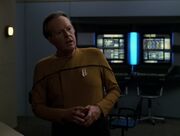
Commander Barclay
In 2404 of an alternate timeline , Barclay managed to stop stuttering (although this affectation resurfaced when he was caught in a lie). He held the rank of commander and became a teacher at Starfleet Academy, teaching a class about the Borg. Barclay later helped Admiral Janeway to travel back in time and return Voyager to Earth sooner than had been done by the vessel's crew. The Doctor learned the truth from him after the addled Tuvok managed to warn him that Janeway was leaving forever. ( VOY : " Endgame ")
Holograms [ ]
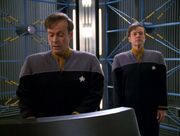
Barclay programming his own hologram
Barclay was holographically duplicated on at least two occasions: In 2371 , the USS Voyager encountered a subspace anomaly which caused a feedback surge through The Doctor's holographic matrix, generating a holographic hallucination. Among the projections created was one of Lieutenant Barclay, who insisted the EMH was Doctor Lewis Zimmerman and that Voyager was merely a simulation he had been running at Jupiter Station. Eventually, the crew of Voyager managed to extract The Doctor's program and deactivate the hallucination. ( VOY : " Projections ")
Barclay created a holographic duplicate of himself to be transmitted to Voyager, where it could aid them in their trip home to Earth. In its first transmission, it was intercepted and reprogrammed as part of a profit scheme devised by three Ferengi, but their plan was ultimately discovered by Barclay himself and the hologram was deactivated. ( VOY : " Inside Man ")
Memorable quotes [ ]
" You know, the people that I create in there are m… more real to me than anyone I meet out here. Except… maybe you, commander. " " I need you out here, Reg – now more than ever. "
" Mr. Barclay! Everyone's still trying to figure out exactly how you did it. " " Well, it… it just occurred to me that I could set up a frequency harmonic between the deflector and the shield grid, using the warp field generator as a power flow anti-attenuator, and that, of course, naturally created an amplification of the inherent energy output. " " Uh-huh, I see that… "
" I've lost myself, Deanna. " " Lost yourself? " " In Voyager . I've become obsessed… with Voyager . "
" Dr. Cochrane, I know this sounds silly, but could I shake your hand? [Cochrane reluctantly shakes it] Oh! Thank you, Doctor! You have no idea what an honor it is to work with you on this project! " " Reg… " " I never thought I would ever meet the man who invented warp drive! I.… " " Reg! " " Hmm…? Oh! Yes, of course. I'm sorry… "
" He traveled half-way across the galaxy to care for Lewis Zimmerman, the man who created his program. It was like a son who wanted to show his father what he'd become, so the old man would be proud of him. And if you ask me, he was. "
Appendices [ ]
Appearances [ ].
- " Hollow Pursuits " (Season 3)
- " The Nth Degree " (Season 4)
- " Realm Of Fear " (Season 6)
- " Ship In A Bottle "
- " Genesis " (Season 7)
- Star Trek: First Contact
- " Projections " (Only as a hologram) (Season 2)
- " Pathfinder " (Season 6)
- " Life Line "
- " Inside Man " (Season 7)
- " Author, Author "
- " Endgame "
Background information [ ]
Barclay was played by actor Dwight Schultz .
Origins [ ]
The character of Barclay was conceived by Gene Roddenberry . " He realized that that type of character was missing from the program, " stated Dwight Schultz , " and eventually said, 'Let's fill that spot.' " ( TV Zone , issue 139) Schultz believed that, upon inventing the persona, the writing staff were attempting to create a ground-breakingly relatable character. " I think they thought, 'Hey, why don't we write a character who is just like the rest of the human race and put him on the bridge. I bet our fandom will identify with him.' " ( Star Trek Monthly issue 30 , p. 32)
The scriptwriter Sally Caves set about creating the character, along with the term " holo-addiction ". But when the role of Barclay began to be written, he was described as a contradiction in terms. " But you see, it really has to do with how brilliant he is, " noted Dwight Schultz. " Can you overlook his social skills problem to get to his intelligence, his capability? " ( Starlog #222)
According to the script for "Hollow Pursuits", the character was originally named "Endicott Reginald Barclay III". However, the first and middle names were later switched for his Star Trek: Starship Creator biography. In the same script's teaser description, Barclay was referred to as " a shy individual with a perpetual frown born of stress and unhappiness between his brows […] What we notice most about him is that he is uncomfortable around other people to the point of agony… he rarely makes eye contact… when he speaks, he hesitates, desperately afraid of saying the wrong thing… which he occasionally does. " [1]
Casting [ ]
When he was cast as Barclay, Dwight Schultz had been a Star Trek fan for a long time and had asked Rick Berman to consider him if the right part came along. ( Captains' Logs: The Unauthorized Complete Trek Voyages , p. 196) Whoopi Goldberg was instrumental in arranging for Schultz to play the role of Barclay. " I told her what a big Star Trek fan I was. I asked her what it was like to work with Patrick Stewart […] and she said, 'You gotta be on that show,' " Schultz related. " She went back and told them. Before I knew it, I got a call from my manager asking me if I would like to do it. " ( Starlog #222)
As a big fan of science fiction and with an interest in science as well as pseudoscience, Dwight Schultz thought it was "perfect" for him to be involved in Star Trek . " I was the lucky one chosen, " he remarked. ( TV Zone , issue 139) However, the nature of the part came as something of a surprise to Schultz, who at first thought portraying the character would represent a few days' work involving intensive makeup. " I didn't know Barclay was going to be a recurring character, " he explained. " As far as I was concerned, it was a one-time shot. I was a little disappointed, to tell you the truth, when I got the script for 'Hollow Pursuits', that my character wasn't a vein-bulging alien. " ( Star Trek Monthly issue 30 , p. 32) Schultz discovered that Barclay, in fact, was closer to his own offstage personality than the actor's most famous role, Captain H.M. ("Howling Mad") Murdock from The A-Team . He was not afraid that accepting the part of Barclay would lead to type-casting. " When we talked about Barclay, you know, the whole concept of him on the Holodeck was that he could be four different characters in one room. He could be something different every time. It doesn't stay that same. It's not a continuation. So, in a sense, you see, there isn't a typing. " ( Starlog #222)
Portrayals [ ]
Partly because he was familiar with not only Whoopi Goldberg but also Brent Spiner and Jonathan Frakes as well as several members of the TNG production crew, Dwight Schultz found that making his first guest-star appearance on the show was not an uncomfortable experience. " This was extraordinarily easy for me, " he recalled, " because of all the familiar faces […] The script was a terrific Walter Mitty type fantasy. I got to kiss Marina Sirtis and work with Gates McFadden as well as do a bit of sword fighting with Patrick Stewart […] I had a great time. " ( TV Zone , issue 139)
Soon, plans were made to reprise the character of Barclay. " We put Barclay on our laundry list of things we wanted to bring back fourth season , " noted Michael Piller . ( Cinefantastique , Vol. 22, No. 2, p. 42) However, finding a way to follow up Barclay's debut was quite challenging, and the TNG writing staff struggled with the issue for around a year. They wanted Barclay to reappear in an episode that had a worthwhile story idea, not just once again portraying the character as a nervous officer on the holodeck. It was Joe Menosky who eventually devised the means by which they would have Barclay make a second appearance. Recalled Piller, " Joe had this concept of somebody who became super intelligent and said, 'Maybe this could be our Barclay show.' " Brannon Braga commented, " It was a good twist on that particular character which you could only get to with a science-fiction gag. " Rick Berman contributed to the depiction of Barclay in " The Nth Degree " by suggesting that he play Cyrano De Bergerac in the outing. ( Captains' Logs: The Unauthorized Complete Trek Voyages , pp. 218 & 219)
Barclay was considered for one of the junior officers featured in the TNG episode " Lower Decks ". " An initial discussion was that Barclay might be involved, " recalled Ron Wilkerson , who co-wrote the installment with Jean Louise Matthias , " but we felt pretty strongly we had seen a lot of Barclay already and though he is a strong character, if we put him in this episode, he would overshadow the others. " ( Cinefantastique , Vol. 25/26, No. 6/1, p. 78) Hence, Barclay's omission from "Lower Decks" was because he was regarded as too well-known. ( Star Trek: The Next Generation Companion (3rd ed., p. 282))
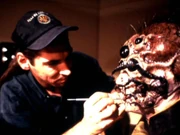
Dwight Schultz's makeup for portraying Barclay as an arachnid is tweaked by Mike Smithson
In Brannon Braga's first draft of " Genesis ", virtually all of the Enterprise 's crew (with the exception of Data) eventually transformed into Barclay, due to Barclay's Protomorphosis Syndrome . The idea of turning Barclay himself into an arachnid during the course of the installment came easily to Braga. " I just thought it would be fun to make Barclay a spider, " Braga stated, " because I can't imagine anything more awful to become. It just seemed natural, since he's a kind of nervous and wiry guy, that maybe he would have had more arachnid ancestors than the other [ Enterprise crew members]. " ( Captains' Logs: The Unauthorized Complete Trek Voyages , pp. 300 & 301) The makeup department was able to create the spider-like creature by using appliances and latex wrinkles applied to the top of Dwight Schultz's head and upper face as well as eye appliances, appliances that looked like spider's eyes, and a spider-leg device that protruded from the side of Barclay's head. ( Star Trek: Aliens & Artifacts , p. 118) " To be able to cast all the individual tentacles, the arms that came off of [the spider makeup], to insert all the little eyes into the makeup [took] days to do it. " ("The Sky's the Limit, The Eclipse of Star Trek: The Next Generation , Part Two: Penumbra", TNG Season 7 Blu-ray special features) Ronald D. Moore greatly enjoyed "watching Dwight Schultz do his impersonation of a spider running through the obs lounge." ( Captains' Logs: The Unauthorized Complete Trek Voyages , p. 301)
René Echevarria felt it "absolutely" would have been fun to send Barclay off with a special final TNG appearance towards the end of the series' seventh season . (" Lower Decks " audio commentary , TNG Season 7 Blu-ray special features)
During early development of Star Trek: Voyager , it was proposed that the holographic main character who ultimately became The Doctor might have the likeness of Barclay and that an episode of Star Trek: The Next Generation 's seventh season could feature Barclay working on the hologram. A summary of ongoing development meetings for Voyager , which was written on 6 August 1993 , posited, " Barclay would have been working on this program and finally takes a leave to put on the polishing touches (on a TNG episode). He creates the character in his own image. " ( A Vision of the Future - Star Trek: Voyager , pp. 182 & 183)
Following the appearance of the Barclay hologram in " Projections ", the continuation of the real Barclay character was not assured. In a 1996 interview, Dwight Schultz confessed, " I'm almost getting too old to do Barclay, because he's a character who has to change in a different way, or go back, or revert to what he was. " ( Starlog #222) In an interview from 1997 , however, Schultz further contemplated returning as a Star Trek guest star, saying, " Who knows? I could be again someday. " ( Star Trek Monthly issue 30 , p. 37)
Reception [ ]
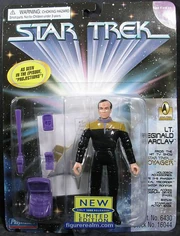
Reginald Barclay action figure (1996)
Dwight Schultz was very thankful for the opportunity to portray Barclay on TNG. ( TV Zone , issue 139) " It was actually quite a brilliant stroke that the writers came up with this completely fallible human being, " he said. " They broke new ground with the character. I didn't do it, the writers did it, and I think they knew it. " ( Star Trek Monthly issue 30 , p. 32) Regarding his TNG appearances, Schultz commented, " I've been blessed with some lovely scripts and a character that people could truly identify with. " Indeed, the response from Star Trek fans to Barclay was extreme. " They really do identify with Barclay because he has difficulties, " Schultz observed. " He's not the super perfect Starfleet Officer you often see in Star Trek, and the audiences love him because of that. " ( TV Zone , issue 139) Schultz heard many times from Star Trek fans that they very much identified with and related to Barclay. ( Star Trek Monthly issue 30 , p. 32)
Schultz liked his character but knew Barclay wasn't without his issues. " Barclay had problems, he wasn't perfect; he was someone that the fans I think could identify with. He had a good heart, but he didn't quite fit in all of the time, and I think it brought a unique perspective for the show and for fans. It was a great idea. They finally put an ordinary person on the bridge, and it struck a chord. Barclay sees things that he is not a part of and desperately wants to be there, just as I did for so many years, wanting to be an actor! He desperately wants to be things that he's not and will never be – he will probably always be a lieutenant, but he has a great heart. I think he recognises that it's very important to fulfill your place, more so than it is to move beyond it, and he was given this very, very sweet disposition by the writers; and I think that sums him up. A great heart, and recognises his place, but he's a Walter Mitty dreamer. It's one of those things that I have been thinking about for a long time. I think Barclay would desperately like to be promoted, yet he has good understanding as to why he would not be. He would be in electronic research of some kind. No question. The computer nerd of the future is what he would be, without doubt! He would be buried in quantum fields and the study of particle accelerators and attempting to divine super warp drives, that sort of thing. It lets you realize first of all, this is all fantasy anyway [and] that there is a place for everyone in the future, even this idealized future that Star Trek represents as opposed to the darker future that Babylon 5 presented. It's very good for the fans to have an ordinary person there, just a regular guy who sometimes is going to make mistakes. " ( Star Trek Magazine issue 113 ), [2] (X)
The popularity of the character with Star Trek fans led to Barclay's reappearances following his introduction in "Hollow Pursuits". ( Star Trek Monthly issue 30 , p. 32) Many fans responded positively to how he was depicted in " The Nth Degree ", which Dwight Schultz cited as his favorite episode, partly due to what happens to the character therein (but also because Schultz approved of the possible future for humanity which that installment suggests). ( Starlog #222)
Michael Piller remarked, " [Barclay] is a very interesting character and a great actor. " ( Captains' Logs: The Unauthorized Complete Trek Voyages , p. 218)
Playmates Toys have released two action figures based on Reginald Barclay; the first, in 1994 , was based on his appearances throughout Star Trek: The Next Generation and the second, in 1996 , was based on his appearance in the Star Trek: Voyager episode "Projections".
Barclay's behaviour has been interpreted as social anxiety disorder and imposter syndrome. [3]
Apocrypha [ ]
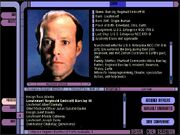
Personnel file for Reginald Barclay in Star Trek: Starship Creator
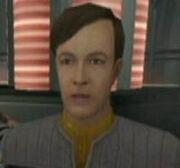
Lieutenant Barclay in Elite Force II
Barclay appears as a selectable crew member in the non-canon video game Star Trek: Starship Creator , in which his personnel file states he was born in 2340 in Cleveland , Ohio and gained a Master's Degree in Computer Systems from the Daystrom Institute in 2362 . It explains he did not attend Starfleet Academy and was instead offered a commission by Starfleet at the rank of lieutenant junior grade, which he accepted. It further states that Barclay's interests were holoprogramming, theater, speculative fiction, and self-help books, and that his father was Reginald Barclay II and his mother was Commander Alicia Barclay, both of whom resided in Swansea, Wales.
In Peter David 's novel Imzadi , Barclay is involuntarily cured of his holo-addiction in 2368 when an aged Admiral Riker, having used the Guardian of Forever to travel back in time and prevent the death of Counselor Troi, materializes in the past on the holodeck during one of Barclay's adventures. Disguising his presence by claiming to be an automatic system programmed to activate if Barclay used his holoprograms again, Admiral Riker instructs Barclay to shut the program down. Barclay is so intimidated by the admiral that he decides never to use the holodeck again. This is inconsistent, however, with the Voyager story line.
In Michael Jan Friedman 's novel Crossover , Barclay transferred back to the Enterprise -D in 2371 when Admiral Leonard McCoy came aboard and wrested command from, and subsequently relinquished command to Captain Picard. Picard soon after took the ship into Romulan space on a rescue mission to retrieve his senior officers, who had been captured in a failed attempt to retrieve Captain Montgomery Scott , who had, in turn, been captured in a failed attempt to retrieve Ambassador Spock .
In Greg Cox 's The Q Continuum trilogy, Barclay discovers that the bio-neural gel packs used in the USS Enterprise -E are capable of absorbing the psionic energy of the galactic barrier , prompting him to suggest that the crew channel the resulting energy into the Enterprise 's shields so that they can increase the time that they can remain in the barrier during an attempt to hide from the Calamarain .
In Diane Duane 's novel Dark Mirror , Lieutenant Commander Barclay is Captain Picard 's chief bodyguard in the mirror universe . While masquerading as his mirror universe counterpart, Picard notes that Barclay's "slightly crazed creativity" has been redirected, replacing his quirkiness with a more hard-edged sense of danger. Picard promises Mirror Barclay a promotion, but he is killed before this can happen. Upon returning to his own universe, Picard achieves a sort of symmetry by noting a special commendation on the "real" Barclay's record as a reward for the extra work he has been putting in.
In the Strange New Worlds short story The Naked Truth , which is set in 2370, Captain Picard orders Barclay to lead his first away mission, installing a new generator core in a space station in the Tarvo system. However, Barclay and his team soon end up fighting for their lives in a Vorel trap.
Barclay also appears in the John Vornholt novels Gemworld, Book One and Book Two , as a crewmember on the Enterprise -E in 2375 shortly after the end of the Dominion War where he helped deal with the Gemworld Crisis.
In the video game Star Trek: Elite Force II , set in 2380, Barclay serves as temporary chief engineer on the Enterprise -E.
In the Kirsten Beyer novel Full Circle , Barclay is assigned to the USS Galen , which has been fitted with a quantum slipstream drive and assigned to Project Full Circle, an expeditionary force sent to explore the Delta Quadrant. The novel takes place in the year 2381 .
In the David A. McIntee novel Indistinguishable from Magic , set in 2383 , Barclay was involved in a transporter project designed to transport a living person over long distances via the Pathfinder Project. He held the record for longest distance transport when Montgomery Scott ordered that Barclay be reassigned to the Starfleet Corps of Engineers USS Challenger as a mission specialist during the investigation of the derelict Intrepid NX-07. After the vessel was hijacked by Berlinghoff Rasmussen and former DaiMon Bok , Barclay was instrumental in returning the crew to the Challenger . When his friend Geordi La Forge was named captain of the Challenger following Captain Scott's retirement, Barclay agreed to remain aboard as chief of operations . During his first mission as chief of operations, the Challenger investigated a new form of technology known as Trans-slipstream and was transported to NGC-4414 along with the rescued crew of the IRW Stormcrow . Teamed with Romulan engineer Voktra (of whom he developed a romantic interest), the two worked to find a way to escape from the region and participated in an away mission to the derelict USS Hera . Following the destruction of the Challenger in order for the crew to return home, Barclay returned to Jupiter Station where he expected to be returned to the Voyager fleet in the Delta Quadrant. He also had proposed to Starfleet an increased Romulan presence in exploration missions, which Voktra also proposed to her government.
External links [ ]
- Reginald Barclay at StarTrek.com
- Reginald Barclay at Memory Beta , the wiki for licensed Star Trek works
- Reginald Barclay at Wikipedia
- 3 Ancient humanoid
The Future of ‘Star Trek’: From ‘Starfleet Academy’ to New Movies and Michelle Yeoh, How the 58-Year-Old Franchise Is Planning for the Next Generation of Fans
“I can’t believe I get to play the captain of the Enterprise.”
“Strange New Worlds” is the 12th “Star Trek” TV show since the original series debuted on NBC in 1966, introducing Gene Roddenberry’s vision of a hopeful future for humanity. In the 58 years since, the “Star Trek” galaxy has logged 900 television episodes and 13 feature films, amounting to 668 hours — nearly 28 days — of content to date. Even compared with “Star Wars” and the Marvel Cinematic Universe, “Star Trek” stands as the only storytelling venture to deliver a single narrative experience for this long across TV and film.
In other words, “Star Trek” is not just a franchise. As Alex Kurtzman , who oversees all “Star Trek” TV production, puts it, “‘Star Trek’ is an institution.”
Without a steady infusion of new blood, though, institutions have a way of fading into oblivion (see soap operas, MySpace, Blockbuster Video). To keep “Star Trek” thriving has meant charting a precarious course to satisfy the fans who have fueled it for decades while also discovering innovative ways to get new audiences on board.
“Doing ‘Star Trek’ means that you have to deliver something that’s entirely familiar and entirely fresh at the same time,” Kurtzman says.
The franchise has certainly weathered its share of fallow periods, most recently after “Nemesis” bombed in theaters in 2002 and UPN canceled “Enterprise” in 2005. It took 12 years for “Star Trek” to return to television with the premiere of “Discovery” in 2017; since then, however, there has been more “Star Trek” on TV than ever: The adventure series “Strange New Worlds,” the animated comedy “Lower Decks” and the kids series “Prodigy” are all in various stages of production, and the serialized thriller “Picard” concluded last year, when it ranked, along with “Strange New Worlds,” among Nielsen’s 10 most-watched streaming original series for multiple weeks. Nearly one in five Paramount+ subscribers in the U.S. is watching at least one “Star Trek” series, according to the company, and more than 50% of fans watching one of the new “Trek” shows also watch at least two others. The new shows air in 200 international markets and are dubbed into 35 languages. As “Discovery” launches its fifth and final season in April, “Star Trek” is in many ways stronger than it’s ever been.
“’Star Trek’s fans have kept it alive more times than seems possible,” says Eugene Roddenberry, Jr., who executive produces the TV series through Roddenberry Entertainment. “While many shows rightfully thank their fans for supporting them, we literally wouldn’t be here without them.”
But the depth of fan devotion to “Star Trek” also belies a curious paradox about its enduring success: “It’s not the largest fan base,” says Akiva Goldsman, “Strange New Worlds” executive producer and co-showrunner. “It’s not ‘Star Wars.’ It’s certainly not Marvel.”
When J.J. Abrams rebooted “Star Trek” in 2009 — with Chris Pine, Zachary Quinto and Zoe Saldaña playing Kirk, Spock and Uhura — the movie grossed more than any previous “Star Trek” film by a comfortable margin. But neither that film nor its two sequels broke $500 million in global grosses, a hurdle every other top-tier franchise can clear without breaking a sweat.
There’s also the fact that “Star Trek” fans are aging. I ask “The Next Generation” star Jonathan Frakes, who’s acted in or directed more versions of “Star Trek” than any other person alive, how often he meets fans for whom the new “Star Trek” shows are their first. “Of the fans who come to talk to me, I would say very, very few,” he says. “‘Star Trek’ fans, as we know, are very, very, very loyal — and not very young.”
As Stapf puts it: “There’s a tried and true ‘Trek’ fan that is probably going to come to every ‘Star Trek,’ no matter what it is — and we want to expand the universe.”
Every single person I spoke to for this story talked about “Star Trek” with a joyful earnestness as rare in the industry as (nerd alert) a Klingon pacifist.
“When I’m meeting fans, sometimes they’re coming to be confirmed, like I’m kind of a priest,” Ethan Peck says during a break in filming on the “Strange New Worlds” set. He’s in full Spock regalia — pointy ears, severe eyebrows, bowl haircut — and when asked about his earliest memories of “Star Trek,” he stares off into space in what looks like Vulcan contemplation. “I remember being on the playground in second or third grade and doing the Vulcan salute, not really knowing where it came from,” he says. “When I thought of ‘Star Trek,’ I thought of Spock. And now I’m him. It’s crazy.”
To love “Star Trek” is to love abstruse science and cowboy diplomacy, complex moral dilemmas and questions about the meaning of existence. “It’s ultimately a show with the most amazing vision of optimism, I think, ever put on-screen in science fiction,” says Kurtzman, who is 50. “All you need is two minutes on the news to feel hopeless now. ‘Star Trek’ is honestly the best balm you could ever hope for.”
I’m getting a tour of the USS Enterprise from Scotty — or, rather, “Strange New World” production designer Jonathan Lee, who is gushing in his native Scottish burr as we step into the starship’s transporter room. “I got such a buzzer from doing this, I can’t tell you,” he says. “I actually designed four versions of it.”
Lee is especially proud of the walkway he created to run behind the transporter pads — an innovation that allows the production to shoot the characters from a brand-new set of angles as they beam up from a far-flung planet. It’s one of the countless ways that this show has been engineered to be as cinematic as possible, part of Kurtzman’s overall vision to make “Star Trek” on TV feel like “a movie every week.”
Kurtzman’s tenure with “Star Trek” began with co-writing the screenplay for Abrams’ 2009 movie, which was suffused with a fast-paced visual style that was new to the franchise. When CBS Studios approached Kurtzman in the mid-2010s about bringing “Star Trek” back to TV, he knew instinctively that it needed to be just as exciting as that film.
“The scope was so much different than anything we had ever done on ‘Next Gen,’” says Frakes, who’s helmed two feature films with the “Next Generation” cast and directed episodes of almost every live-action “Trek” TV series, including “Discovery” and “Strange New Worlds.” “Every department has the resources to create.”
A new science lab set for Season 3, for example, boasts a transparent floor atop a four-foot pool of water that swirls underneath the central workbench, and the surrounding walls sport a half dozen viewscreens with live schematics custom designed by a six-person team. “I like being able to paint on a really big canvas,” Kurtzman says. “The biggest challenge is always making sure that no matter how big something gets, you’re never losing focus on that tiny little emotional story.”
At this point, is there a genre that “Strange New Worlds” can’t do? “As long as we’re in storytelling that is cogent and sure handed, I’m not sure there is,” Goldsman says with an impish smile. “Could it do Muppets? Sure. Could it do black and white, silent, slapstick? Maybe!”
This approach is also meant to appeal to people who might want to watch “Star Trek” but regard those 668 hours of backstory as an insurmountable burden. “You shouldn’t have to watch a ‘previously on’ to follow our show,” Myers says.
To achieve so many hairpin shifts in tone and setting while maintaining Kurtzman’s cinematic mandate, “Strange New Worlds” has embraced one of the newest innovations in visual effects: virtual production. First popularized on the “Star Wars” series “The Mandalorian,” the technology — called the AR wall — involves a towering circular partition of LED screens projecting a highly detailed, computer-generated backdrop. Rather than act against a greenscreen, the actors can see whatever fantastical surroundings their characters are inhabiting, lending a richer level of verisimilitude to the show.
But there is a catch. While the technology is calibrated to maintain a proper sense of three-dimensional perspective through the camera lens, it can be a bit dizzying for anyone standing on the set. “The images on the walls start to move in a way that makes no sense,” says Mount. “You end up having to focus on something that’s right in front of you so you don’t fall down.”
And yet, even as he’s talking about it, Mount can’t help but break into a boyish grin. “Sometimes we call it the holodeck,” he says. In fact, the pathway to the AR wall on the set is dotted with posters of the virtual reality room from “The Next Generation” and the words “Enter Holodeck” in a classic “Trek” font.
“I want to take one of those home with me,” Peck says. Does the AR wall also affect him? “I don’t really get disoriented by it. Spock would not get ill, so I’m Method acting.”
I’m on the set of the “Star Trek” TV movie “Section 31,” seated in an opulent nightclub with a view of a brilliant, swirling nebula, watching Yeoh rehearse with director Olatunde Osunsanmi and her castmates. Originally, the project was announced as a TV series centered on Philippa Georgiou, the semi-reformed tyrant Yeoh originated on “Discovery.” But between COVID delays and the phenomenon of “Everything Everywhere All at Once,” there wasn’t room in the veteran actress’s schedule to fit a season of television. Yeoh was undaunted.
“We’d never let go of her,” she says of her character. “I was just blown away by all the different things I could do with her. Honestly, it was like, ‘Let’s just get it done, because I believe in this.’”
If that means nothing to you, don’t worry: The enormity of the revelation that Garrett is being brought back is meant only for fans. If you don’t know who the character is, you’re not missing anything.
“It was always my goal to deliver an entertaining experience that is true to the universe but appeals to newcomers,” says screenwriter Craig Sweeny. “I wanted a low barrier of entry so that anybody could enjoy it.”
Nevertheless, including Garrett on the show is exactly the kind of gasp-worthy detail meant to flood “Star Trek” fans with geeky good feeling.
“You cannot create new fans to the exclusion of old fans,” Kurtzman says. “You must serve your primary fan base first and you must keep them happy. That is one of the most important steps to building new fans.”
On its face, that maxim would make “Section 31” a genuine risk. The titular black-ops organization has been controversial with “Star Trek” fans since it was introduced in the 1990s. “The concept is almost antagonistic to some of the values of ‘Star Trek,’” Sweeny says. But he still saw “Section 31” as an opportunity to broaden what a “Star Trek” project could be while embracing the radical inclusivity at the heart of the franchise’s appeal.
“Famously, there’s a spot for everybody in Roddenberry’s utopia, so I was like, ‘Well, who would be the people who don’t quite fit in?’” he says. “I didn’t want to make the John le Carré version, where you’re in the headquarters and it’s backbiting and shades of gray. I wanted to do the people who were at the edges, out in the field. These are not people who necessarily work together the way you would see on a ‘Star Trek’ bridge.”
For Osunsanmi, who grew up watching “The Next Generation” with his father, it boils down to a simple question: “Is it putting good into the world?” he asks. “Are these characters ultimately putting good into the world? And, taking a step back, are we putting good into the world? Are we inspiring humans watching this to be good? That’s for me what I’ve always admired about ‘Star Trek.’”
Should “Section 31” prove successful, Yeoh says she’s game for a sequel. And Kurtzman is already eyeing more opportunities for TV movies, including a possible follow-up to “Picard.” The franchise’s gung-ho sojourn into streaming movies, however, stands in awkward contrast to the persistent difficulty Paramount Pictures and Abrams’ production company Bad Robot have had making a feature film following 2016’s “Star Trek Beyond” — the longest theaters have gone without a “Star Trek” movie since Paramount started making them.
First, a movie reuniting Pine’s Capt. Kirk with his late father — played in the 2009 “Star Trek” by Chris Hemsworth — fell apart in 2018. Around the same time, Quentin Tarantino publicly flirted with, then walked away from, directing a “Star Trek” movie with a 1930s gangster backdrop. Noah Hawley was well into preproduction on a “Star Trek” movie with a brand-new cast, until then-studio chief Emma Watts abruptly shelved it in 2020. And four months after Abrams announced at Paramount’s 2022 shareholders meeting that his 2009 cast would return for a movie directed by Matt Shakman (“WandaVision”), Shakman left the project to make “The Fantastic Four” for Marvel. (It probably didn’t help that none of the cast had been approached before Abrams made his announcement.)
The studio still intends to make what it’s dubbed the “final chapter” for the Pine-Quinto-Saldaña cast, and Steve Yockey (“The Flight Attendant”) is writing a new draft of the script. Even further along is another prospective “Star Trek” film written by Seth Grahame-Smith (“Abraham Lincoln: Vampire Hunter”) and to be directed by Toby Haynes (“Andor,” “Black Mirror: USS Callister”) that studio insiders say is on track to start preproduction by the end of the year. That project will serve as an origin story of sorts for the main timeline of the entire franchise. In both cases, the studio is said to be focused on rightsizing the budgets to fit within the clear box office ceiling for “Star Trek” feature films.
Far from complaining, everyone seems to relish the challenge. Visual effects supervisor Jason Zimmerman says that “working with Alex, the references are always at least $100 million movies, if not more, so we just kind of reverse engineer how do we do that without having to spend the same amount of money and time.”
The workload doesn’t seem to faze him either. “Visual effects people are a big, big ‘Star Trek’ fandom,” he says. “You naturally just get all these people who go a little bit above and beyond, and you can’t trade that for anything.”
In one of Kurtzman’s several production offices in Toronto, he and production designer Matthew Davies are scrutinizing a series of concept drawings for the newest “Star Trek” show, “Starfleet Academy.” A bit earlier, they showed me their plans for the series’ central academic atrium, a sprawling, two-story structure that will include a mess hall, amphitheater, trees, catwalks, multiple classrooms and a striking view of the Golden Gate Bridge in a single, contiguous space. To fit it all, they plan to use every inch of Pinewood Toronto’s 45,900 square foot soundstage, the largest in Canada.
But this is a “Star Trek” show, so there do need to be starships, and Kurtzman is discussing with Davies about how one of them should look. The issue is that “Starfleet Academy” is set in the 32nd century, an era so far into the future Kurtzman and his team need to invent much of its design language.
“For me, this design is almost too Klingon,” Kurtzman says. “I want to see the outline and instinctively, on a blink, recognize it as a Federation ship.”
The time period was first introduced on Season 3 of “Discovery,” when the lead character, Michael Burnham (Sonequa Martin-Green), transported the namesake starship and its crew there from the 23rd century. “It was exciting, because every time we would make a decision, we would say, ‘And now that’s canon,’” says Martin-Green.
“We listened to a lot of it,” Kurtzman says. “I think I’ve been able to separate the toxic fandom from really true fans who love ‘Star Trek’ and want you to hear what they have to say about what they would like to see.”
By Season 2, the “Discovery” writers pivoted from its dour, war-torn first season and sent the show on its trajectory 900-plus years into the future. “We had to be very aware of making sure that Spock was in the right place and that Burnham’s existence was explained properly, because she was never mentioned in the original series,” says executive producer and showrunner Michelle Paradise. “What was fun about jumping into the future is that it was very much fresh snow.”
That freedom affords “Starfleet Academy” far more creative latitude while also dramatically reducing how much the show’s target audience of tweens and teens needs to know about “Star Trek” before watching — which puts them on the same footing as the students depicted in the show. “These are kids who’ve never had a red alert before,” Noga Landau, executive producer and co-showrunner, says. “They never had to operate a transporter or be in a phaser fight.”
In the “Starfleet Academy” writers’ room in Secret Hideout’s Santa Monica offices, Kurtzman tells the staff — a mix of “Star Trek” die-hards, part-time fans and total newbies — that he wants to take a 30,000-foot view for a moment. “I think we need to ground in science more throughout the show,” he says, a giant framed photograph of Spock ears just over his shoulder. “The kids need to use science more to solve problems.”
Immediately, one of the writers brightens. “Are you saying we can amp up the techno-babble?” she says. “I’m just excited I get to use my computer science degree.”
After they break for lunch, Kurtzman is asked how much longer he plans to keep making “Star Trek.”
“The minute I fall out of love with it is the minute that it’s not for me anymore. I’m not there yet,” he says. “To be able to build in this universe to tell stories that are fundamentally about optimism and a better future at a time when the world seems to be falling apart — it’s a really powerful place to live every day.”
More From Our Brands
Sebastian stan looks ready to violate the fair housing act as donald trump in ‘the apprentice’, this luxe 157-foot catamaran lets you explore the galápagos with a personal butler, nba, wnba media rights better off sold together: adam silver, the best loofahs and body scrubbers, according to dermatologists, survivor’s sixth castaway out says butting heads with q led to the night’s first big blindside, verify it's you, please log in.

IMAGES
VIDEO
COMMENTS
(Star Trek: The Next Generation 365, p. 199) The Feynman was named for physicist Richard Feynman. (Star Trek: The Next Generation Companion (2nd ed., p. 160)) Production [] "The Nth Degree" was filmed between Monday 28 January 1991 and Tuesday 5 February 1991 on Paramount Stage 8, 9, and 16.
The Nth Degree: Directed by Robert Legato. With Patrick Stewart, Jonathan Frakes, LeVar Burton, Michael Dorn. When assigned to investigate an unknown probe, Lt. Barclay is hit by an energy surge, through a shuttlecraft's computer, and he receives an inexplicable boost of confidence and a vast increase in his knowledge.
Star Trek: The Next Generation. ) " The Nth Degree " is the 93rd episode of the American science fiction television series Star Trek: The Next Generation, and the 19th episode of the fourth season . Set in the 24th century, the series follows the adventures of the Starfleet crew of the Federation starship Enterprise-D .
4.19 Nth Degree. The episode opens as Lt. Reg Barclay and Dr. Crusher perform some AmDram in front of the crew, whose enlightened 24 th Century dispositions allow them to appreciate even the most ...
The Nth Degree Aired Apr 1, 1991 Sci-Fi Fantasy Adventure Drama Reviews An alien probe threatens the Enterprise when it emits an energy surge that turns an innocuous crew member into a superhuman.
The Nth Degree Star Trek: The Next Generation. Jump to. Edit. Summaries. When assigned to investigate an unknown probe, Lt. Barclay is hit by an energy surge, through a shuttlecraft's computer, and he receives an inexplicable boost of confidence and a vast increase in his knowledge. The Enterprise checks on the Argus array, a giant Federation ...
"The Nth Degree" is the 93rd episode of the American science fiction television series Star Trek: The Next Generation, and the 19th episode of the fourth season. Set in the 24th century, the series follows the adventures of the Starfleet crew of the Federation starship Enterprise-D. Rob Legato directed and oversaw visual effects for the episode. He created a 3-D effect where the Cytherian's ...
Star Trek: The Next Generation The Nth Degree Sci-Fi Apr 1, 1991 43 min Paramount+ Available on Paramount+, Prime Video, iTunes S4 E19: A crewmember is endowed with super human intelligence by an alien probe and threatens the fate of the Enterprise. Sci-Fi Apr 1, 1991 43 min Paramount+ ...
© 2024 CBS Studios Inc., Paramount Pictures Corporation, and CBS Interactive Inc., Paramount companies. STAR TREK and related marks are trademarks of CBS Studios Inc.
Wham Shot: Barclay sitting calmly in a chair on the holodeck with lasers shooting into his head, speaking through the computer without moving his mouth. You Are Too Late: Said word for word by Barclay when Geordi tries to bypass his link to the ship's computer. A page for describing Recap: Star Trek: The Next Generation S4E19 "The Nth Degree".
Star Trek: The Next Generation; About; Back to video . Search ; Sign Up. Sign In; Shows ; Movies ; Live TV ; Sports ; News ... Sign up for Paramount+ to stream this video. TRY IT FREE . The Nth Degree. Help. S4 E19 45M TV-PG. When a crewmember is endowed with super human intelligence by an alien probe, he threatens the fate of the Enterprise ...
In-depth critical reviews of Star Trek and some other sci-fi series. Includes all episodes of Star Trek: The Original Series, The Animated Series, The Next Generation, Deep Space Nine, Voyager, Enterprise, Discovery, Picard, Lower Decks, Prodigy, and Strange New Worlds. ... "The Nth Degree" is a splendidly unique amalgam of tones and themes ...
The Nth Degree The crew of the USS Enterprise prepare to dock at a space station for rest and relaxation, but their plans are interrupted when the station repor. ... We are a Star Trek fan site, dedicated to providing exciting synopses and plot summaries for our favorite episodes. Latest. The Star Gazer. April 9, 2024. Into the Forest I Go.
Star Trek The Next Generation Season 4 Episode 19 The Nth Degree
"Star Trek: The Next Generation" The Nth Degree (TV Episode 1991) cast and crew credits, including actors, actresses, directors, writers and more. Menu. ... My favorite Star-Trek Episode list of all time a list of 38 titles created 31 Mar 2020 Star Trek a list of 41 titles ...
Star Trek: The Next Generation (TNG) is an American science fiction television series created by Gene Roddenberry. It originally aired from September 28, 1987, to May 23, 1994, in syndication, spanning 178 episodes over seven seasons. ... "The Nth Degree" "Qpid" "The Drumhead" "Half a Life" "The Host" "The Mind's Eye" "In Theory" "Redemption ...
Three people from that original group have vanished, two of them stealing a shuttle to escape. Now Susanna Leitjen, the commander of the away team and Geordi's former superior officer, has joined ...
The Nth Degree Stardate: 44704.2 Original Airdate: 1 Apr, 1991 [Ship's theatre] (A production of a scene from Cyrano de Bergerac, with Reginald Barclay in the title role and Beverly Crusher as Roxanne) ... The Star Trek web pages on this site are for educational and entertainment purposes only. All other copyrights property of their respective ...
A year later, in "The Nth Degree," Barclay is now more involved in group activities on the ship, taking part in one of Dr. Crusher's plays.Troi and Riker, previously wary of Barclay, rush to congratulate him on the progress he's made in the past year. Troi doesn't spare the praise, "You used to withdraw onto the holodeck.
"Star Trek: The Next Generation" The Nth Degree (TV Episode 1991) Dwight Schultz as Barclay. Menu. ... STAR TREK THE NEXT GENERATION SEASON 4 (1990) (8.0/10) a list of 26 titles created 11 Aug 2012 Jornada nas Estrelas: A Nova Geração 4ª Temporada a list of 26 titles ...
The script notes for "The Nth Degree" described what appeared simply as "a holographic-type image of an alien being. It is an odd combination of intense curiosity, lightheartedness, quickness and benevolence. ... According to an internal reference document, listing all the aliens seen in Star Trek: The Next Generation, which was circulated ...
Set in the 24th century, the series follows the adventures of the Starfleet crew of the Federation starship Enterprise-D. Rob Legato directed and oversaw visual effects for the episode. He created a 3-D effect where the Cytherian's huge head appears to pop out of the screen, allowing him to have a face-to-face conversation with Picard. "The Nth ...
Lieutenant Reginald Endicott Barclay III (often referred to as "Reg") was a highly talented Human Starfleet systems diagnostic engineer who lived in the 24th century. In his early days aboard the Enterprise-D, he frequently displayed nervous behavior, demonstrated a noticeable lack of confidence, stammered frequently, was extremely introverted, and occasionally bumbled. These traits aroused ...
Michelle Yeoh just wrapped filming the first "Star Trek" TV movie, "Section 31," a spy thriller that the Oscar winner characterizes as "'Mission: Impossible' in space.". And this ...